What is fiction and why does it matter? Metafiction addresses these questions. Metafiction is fiction about fiction, or fiction that is somehow self-reflective. This is a list of the most important metafictional texts and works that contain metafictional elements, including some metapoems and metaplays, with explanations of what makes them metafiction. For those who want to read more about certain selections, I have included links to relevant posts on my blog and outside sources. This list is not meant to be comprehensive but to give readers an idea of the range and richness of metafiction. Delicious! Enjoy! For a more selective list, see my post Top Twenty One Metafictional Works: The Story That Swallows Its Tale.
Adams, Douglas. The Hitchhiker’s Guide to the Galaxy. 1979.
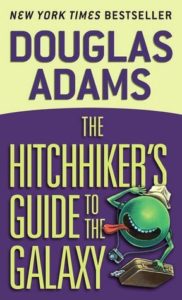 Characters consult The Hitchhiker’s Guide to the Galaxy in the playful science fiction novel of the same name. This is an example of a mise en abyme, or a book within a book. (To read more about mise en abyme, check out my post The Mirror in the Text, Part II: Mise en Abyme.) Link to Amazon
Characters consult The Hitchhiker’s Guide to the Galaxy in the playful science fiction novel of the same name. This is an example of a mise en abyme, or a book within a book. (To read more about mise en abyme, check out my post The Mirror in the Text, Part II: Mise en Abyme.) Link to Amazon
Ara 13. Drawers & Booths: A Metafictional Novel. 2007.
 “Beginning as a modern military civil affairs action, Drawers & Booths spirals into a metafictional journey, testing the boundaries of reader and author, narrative voice, and characterization–the wrapping for Ara 13’s satirical analysis of morality in light of evolutionary psychology,” says Amazon.com.
“Beginning as a modern military civil affairs action, Drawers & Booths spirals into a metafictional journey, testing the boundaries of reader and author, narrative voice, and characterization–the wrapping for Ara 13’s satirical analysis of morality in light of evolutionary psychology,” says Amazon.com.
Link to Amazon
The Arabian Nights. Ed. Daniel Heller-Roazen and Muhsin Mahdi. Trans. Husain Haddawy.
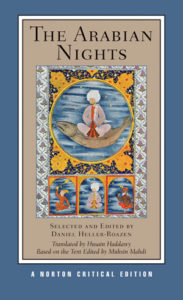 The Arabian Nights is a story of stories. Not only is it a rich interwoven carpet of stories within stories within stories within stories, it is also a story about the power of stories to saves lives, as Scheherzade must tell stories every night to the king so that he will not execute her. (Check out my writings about The Nights: Eros and the Arabesque: The Serial Proliferation of Life in The Arabian Nights, 10,001 Nights: The Frame Stories around the Frame Story, The Power of Stories to Change the World: Another Arabian Night, 1001 Ways to Save Your Life.)
The Arabian Nights is a story of stories. Not only is it a rich interwoven carpet of stories within stories within stories within stories, it is also a story about the power of stories to saves lives, as Scheherzade must tell stories every night to the king so that he will not execute her. (Check out my writings about The Nights: Eros and the Arabesque: The Serial Proliferation of Life in The Arabian Nights, 10,001 Nights: The Frame Stories around the Frame Story, The Power of Stories to Change the World: Another Arabian Night, 1001 Ways to Save Your Life.)
Link to Amazon
Ashbery, John. “Paradoxes and Oxymorons.” 1981.
A poem about poetry, a poem about writing, a poem about reading, a poem about itself. (Read the poem and my interpretation of it in A Simple Metapoem for an Oxymoron: You, as well as Megan Snyder-Camp’s excellent essay “Savoring the Movement of the Mind.” Check out some of my own metapoems.)
Link to Amazon
Atwood, Margaret. The Blind Assassin. 2000.
 “Is it a trick if the author tells you what she’s doing up front? After all, Atwood’s novel within a novel announces itself with a title and publisher and publication date, and then goes on to tell us secrets we might not otherwise have known. Sure, it’s a trick — but a masterful one,” claims Emily Temple in “10 Phenomenally Tricky Books Everyone Should Read.”
“Is it a trick if the author tells you what she’s doing up front? After all, Atwood’s novel within a novel announces itself with a title and publisher and publication date, and then goes on to tell us secrets we might not otherwise have known. Sure, it’s a trick — but a masterful one,” claims Emily Temple in “10 Phenomenally Tricky Books Everyone Should Read.”
Link to Amazon.
Auster, Paul. New York Trilogy. 1986.
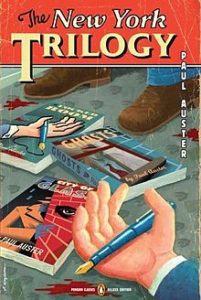 “Ostensibly presented as detective fiction, the stories of The New York Trilogy have been described as ‘meta-detective-fiction’, ‘anti-detective fiction’, ‘mysteries about mysteries’, a ‘strangely humorous working of the detective novel’, ‘very soft-boiled’, a ‘metamystery’ and a ‘mixture between the detective story and the nouveau roman’. . . . The New York Trilogy is a particular form of postmodern detective fiction which still uses well-known elements of the detective novel (the classical and hardboiled varieties, for example) but also creates a new form that links ‘the traditional features of the genre with the experimental, metafictional and ironic features of postmodernism,'” writes Wikipedia. (Read more about the book: “Self with Thousand Masks in Paul Auster’s New York Trilogy” by Bülent C. Tanritanir.)
“Ostensibly presented as detective fiction, the stories of The New York Trilogy have been described as ‘meta-detective-fiction’, ‘anti-detective fiction’, ‘mysteries about mysteries’, a ‘strangely humorous working of the detective novel’, ‘very soft-boiled’, a ‘metamystery’ and a ‘mixture between the detective story and the nouveau roman’. . . . The New York Trilogy is a particular form of postmodern detective fiction which still uses well-known elements of the detective novel (the classical and hardboiled varieties, for example) but also creates a new form that links ‘the traditional features of the genre with the experimental, metafictional and ironic features of postmodernism,'” writes Wikipedia. (Read more about the book: “Self with Thousand Masks in Paul Auster’s New York Trilogy” by Bülent C. Tanritanir.)
Link to Amazon
Ballard, J. G. The Atrocity Exhibition. 1969.
 “Ballard’s novel is known mainly for its prophecy of Ronald Reagan’s presidency, but just as prescient is its anticipation of the psychopathology of much post-conceptual art – particularly its tendency to explore social hypotheses within either a self-fictioning or ‘metafictional’ framework,” explains John Ashton in “J.G. Ballard: Atrocity Exhibition,” which appeared in Map Magazine. (Read more about Ballard’s metafictional novel on squidoo.com.)
“Ballard’s novel is known mainly for its prophecy of Ronald Reagan’s presidency, but just as prescient is its anticipation of the psychopathology of much post-conceptual art – particularly its tendency to explore social hypotheses within either a self-fictioning or ‘metafictional’ framework,” explains John Ashton in “J.G. Ballard: Atrocity Exhibition,” which appeared in Map Magazine. (Read more about Ballard’s metafictional novel on squidoo.com.)
Link to Amazon
Barnes, Julian. History of the World in 10 1/2 Chapters. 1990.
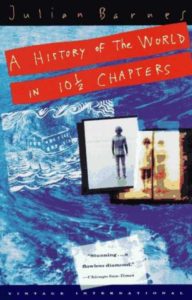 Intertwined stories of ships “make up Barnes’s witty and sometimes acerbic retelling of the history of the world. The stories are connected, if only tangentially, which is precisely Barnes’s point: historians may tell us that ‘there was a pattern,’ but history is ‘just voices echoing in the dark; . . . strange links, impertinent connections,” writes Barbara Hoffert in “Library Journal.” (Learn more about Barnes’ novel and other historiographic metafiction in The End of History in Historiographic Metafiction by Alice Mandricardo. Read about the problematic distinction between history and fiction in my book Narrative Madness and the following posts: The Conventions of Metafiction, Relevance of Metafiction in the Age of Information, History is an Angel Blown Backward through Time, La Mancha: The Stain of Truth, It’s All Fiction: Another Attempt to Tell the Story, and A Not-Not True Tale about a Very Short, Simple Morning.
Intertwined stories of ships “make up Barnes’s witty and sometimes acerbic retelling of the history of the world. The stories are connected, if only tangentially, which is precisely Barnes’s point: historians may tell us that ‘there was a pattern,’ but history is ‘just voices echoing in the dark; . . . strange links, impertinent connections,” writes Barbara Hoffert in “Library Journal.” (Learn more about Barnes’ novel and other historiographic metafiction in The End of History in Historiographic Metafiction by Alice Mandricardo. Read about the problematic distinction between history and fiction in my book Narrative Madness and the following posts: The Conventions of Metafiction, Relevance of Metafiction in the Age of Information, History is an Angel Blown Backward through Time, La Mancha: The Stain of Truth, It’s All Fiction: Another Attempt to Tell the Story, and A Not-Not True Tale about a Very Short, Simple Morning.
Link to Amazon)
Barth, John. “Dunyazadiad.” Chimera. 1972.
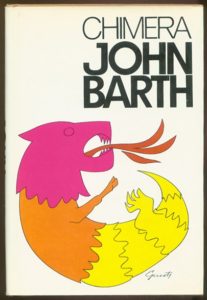 A retelling of The Arabian Nights, the famous story of stories, from the perspective of Sheherazade’s sister Dinazade. (Take a look at my writings about The Nights: Eros and the Arabesque: The Serial Proliferation of Life in The Arabian Nights, 10,001 Nights: The Frame Stories around the Frame Story, The Power of Stories to Change the World: Another Arabian Night, 1001 Ways to Save Your Life.)
A retelling of The Arabian Nights, the famous story of stories, from the perspective of Sheherazade’s sister Dinazade. (Take a look at my writings about The Nights: Eros and the Arabesque: The Serial Proliferation of Life in The Arabian Nights, 10,001 Nights: The Frame Stories around the Frame Story, The Power of Stories to Change the World: Another Arabian Night, 1001 Ways to Save Your Life.)
Link to Amazon
–. The Last Voyage of Somebody the Sailor. 1991.
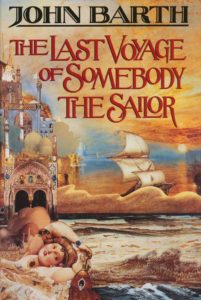 Another reinvention of The Arabian Nights. “Simon Behler–or Baylor, as he refers to himself in his countless best-selling books of New Journalism–falls overboard during a cruise retracing the legendary voyages of Sindbad the Sailor and is pulled from the water by contemporaries of the real Sinbad. Trapped in the distant past but never at a loss for words, Behler–or Bey el-Loor, as he is now known–amuses his new friends with his exotic tales,” writes Edward B. St. John.
Another reinvention of The Arabian Nights. “Simon Behler–or Baylor, as he refers to himself in his countless best-selling books of New Journalism–falls overboard during a cruise retracing the legendary voyages of Sindbad the Sailor and is pulled from the water by contemporaries of the real Sinbad. Trapped in the distant past but never at a loss for words, Behler–or Bey el-Loor, as he is now known–amuses his new friends with his exotic tales,” writes Edward B. St. John.
Link to Amazon
–. “Lost in the Funhouse.” Lost in the Funhouse. 1968.
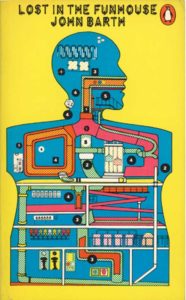 We are lost in our fictions, lost in the funhouse of our own inventions. This short story is also metafictional because it addresses “the specific conventions of story, such as title, paragraphing or plots” (Webster’s Online Dictionary). (Read more about this metafictional classic on the blog The Voice Imitator. Also the book is mentioned in my post The Danger of Meta: Pompidou and David Foster Wallace’s Octet.)
We are lost in our fictions, lost in the funhouse of our own inventions. This short story is also metafictional because it addresses “the specific conventions of story, such as title, paragraphing or plots” (Webster’s Online Dictionary). (Read more about this metafictional classic on the blog The Voice Imitator. Also the book is mentioned in my post The Danger of Meta: Pompidou and David Foster Wallace’s Octet.)
Link to Amazon
–. “Night Sea Journey.” Lost in the Funhouse. 1968.
Sperm and cultural artifacts, like this piece of short fiction, pass on their information in much the same way. Let Barth inseminate you. (If you’d like to learn more, go to my essay: Our Cultural and Genetic Heritage: John Barth’s “Night Sea Journey.”)
Link to Amazon
Barthelme, Donald. “The School.” Amateurs. 1976.
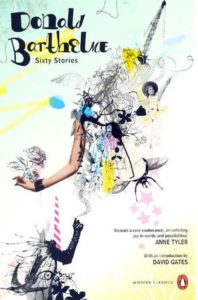 Almost all Barthelme’s short stories are metafictional. This one asks some important questions. Why do we go to school? Why do we learn? Why do we die? I don’t know and neither does the teacher in Barthelme’s enigmatic story “The School.” The short piece of fiction challenges the very purpose of education (and literature) which cannot hope to answer the most important questions. (Read my metafictional introduction: Meta-Introduction to Donald Barthelme and “The School.”)
Almost all Barthelme’s short stories are metafictional. This one asks some important questions. Why do we go to school? Why do we learn? Why do we die? I don’t know and neither does the teacher in Barthelme’s enigmatic story “The School.” The short piece of fiction challenges the very purpose of education (and literature) which cannot hope to answer the most important questions. (Read my metafictional introduction: Meta-Introduction to Donald Barthelme and “The School.”)
Link to Amazon.
–. Snow White. 1967.
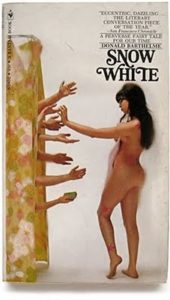 Not only is Snow White metafictional because it totally reinvents the story of Snow White (one of the first novels to do so), but also because it includes many metafictional elements such as a quiz at the end of the first part which asks the reader in a questionnaire, “Do you like the story so far? Yes ( ) No ( ).” The story even asks the reader to participate in the production of meaning: “Has the work, for you, a metaphysical dimension? Yes ( ) No ( ) / What is it (twenty-five words or less)?” (Check out my post “Do You Like the Story So Far? Metafiction in Barthelme’s Snow White.”
Not only is Snow White metafictional because it totally reinvents the story of Snow White (one of the first novels to do so), but also because it includes many metafictional elements such as a quiz at the end of the first part which asks the reader in a questionnaire, “Do you like the story so far? Yes ( ) No ( ).” The story even asks the reader to participate in the production of meaning: “Has the work, for you, a metaphysical dimension? Yes ( ) No ( ) / What is it (twenty-five words or less)?” (Check out my post “Do You Like the Story So Far? Metafiction in Barthelme’s Snow White.”
Link to Amazon)
–. “Views of My Father Weeping.” City Life. 1970.
 “Stories like . . . Barthelme’s ‘Views of My Father Weeping’ (in City Life) take the modernist conception of spatial form to logical conclusion. They offer a set of alternative stories as one story, which can be explained neither as happening simultaneously (because they can only be substitutions for each other) nor as happening in sequence (because they cannot be combined according to normal logic: they erase or cancel out each other,” argues Patricia Waugh in Metafiction: The Theory and Practice of Self Conscious Fiction. (Check out Larry McCaffery’s article “Donald Barthelme and the Metafictional Muse.”)
“Stories like . . . Barthelme’s ‘Views of My Father Weeping’ (in City Life) take the modernist conception of spatial form to logical conclusion. They offer a set of alternative stories as one story, which can be explained neither as happening simultaneously (because they can only be substitutions for each other) nor as happening in sequence (because they cannot be combined according to normal logic: they erase or cancel out each other,” argues Patricia Waugh in Metafiction: The Theory and Practice of Self Conscious Fiction. (Check out Larry McCaffery’s article “Donald Barthelme and the Metafictional Muse.”)
Link to Amazon
Beagle, Peter S. The Last Unicorn. 1968.
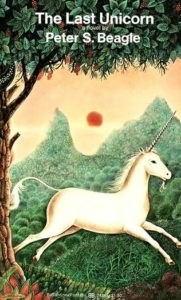 “Characters who do things because those actions are what they would expect from characters in a story” (Webster Online Dictionary). Beagle “reminds us that we are each heroes of our own stories – whether we stick to the literary conventions of genre or not. The inclusion of subtle anachronisms and metafictional commentaries like these clues us to Beagle’s art – the creation of a new kind of fairy tale, one which attempts to make our own world, our own lives, sources of almost limitless wonder and joy, as well as of continuing epic challenges,” writes mp on a review review from Amazon.com.
“Characters who do things because those actions are what they would expect from characters in a story” (Webster Online Dictionary). Beagle “reminds us that we are each heroes of our own stories – whether we stick to the literary conventions of genre or not. The inclusion of subtle anachronisms and metafictional commentaries like these clues us to Beagle’s art – the creation of a new kind of fairy tale, one which attempts to make our own world, our own lives, sources of almost limitless wonder and joy, as well as of continuing epic challenges,” writes mp on a review review from Amazon.com.
Link to Amazon
The Bible.
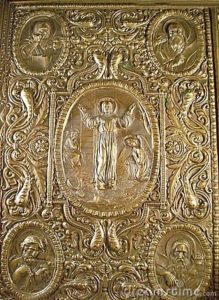 God creates himself (“I am that I am”) and the universe (“Let there be light”) through words. Hebrews believed in mystical connection between letters and the world, expressed most clearly in Kabbalism. The new testament continues this metafictional connection between text and God: “In the beginning was the word and the word was with God and the word was God.” (Discover more about the metafictional elements of the bible in my post: The Early History of Metafiction.)
God creates himself (“I am that I am”) and the universe (“Let there be light”) through words. Hebrews believed in mystical connection between letters and the world, expressed most clearly in Kabbalism. The new testament continues this metafictional connection between text and God: “In the beginning was the word and the word was with God and the word was God.” (Discover more about the metafictional elements of the bible in my post: The Early History of Metafiction.)
Boccaccio, Giovanni. The Decameron. 1531 or 1533.
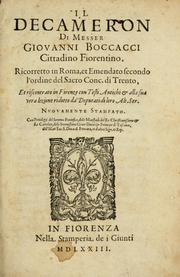 Description: A story about story-telling. In the time of the plague, a group of seven young women and three young men escape the horrors of the city by retiring to the country where they tell each other stories to help each other forget the plague, pass the time, entertain each other, and educate themselves. Boccaccio includes himself as a character — Dioneo — and also fictionalized his lover in the character of Fiammetta. (Check out my post: The Decameron with and without a Frame.)
Description: A story about story-telling. In the time of the plague, a group of seven young women and three young men escape the horrors of the city by retiring to the country where they tell each other stories to help each other forget the plague, pass the time, entertain each other, and educate themselves. Boccaccio includes himself as a character — Dioneo — and also fictionalized his lover in the character of Fiammetta. (Check out my post: The Decameron with and without a Frame.)
Online edition / Link to Amazon
Borges, Jorge Luis. “The Library of Babel.” 1941.
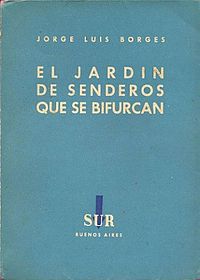 “Borges’ narrator describes how his universe consists of an enormous expanse of adjacent hexagonal rooms, each of which contains the bare necessities for human survival—and four walls of bookshelves. Though the order and content of the books is random and apparently completely meaningless, the inhabitants believe that the books contain every possible ordering of just 25 basic characters (22 letters, the period, the comma, and the space). Though the vast majority of the books in this universe are pure gibberish, the library also must contain, somewhere, every coherent book ever written, or that might ever be written, and every possible permutation or slightly erroneous version of every one of those books. The narrator notes that the library must contain all useful information, including predictions of the future, biographies of any person, and translations of every book in all languages. Conversely, for many of the texts some language could be devised that would make it readable with any of a vast number of different contents,” according to Wikipedia.
“Borges’ narrator describes how his universe consists of an enormous expanse of adjacent hexagonal rooms, each of which contains the bare necessities for human survival—and four walls of bookshelves. Though the order and content of the books is random and apparently completely meaningless, the inhabitants believe that the books contain every possible ordering of just 25 basic characters (22 letters, the period, the comma, and the space). Though the vast majority of the books in this universe are pure gibberish, the library also must contain, somewhere, every coherent book ever written, or that might ever be written, and every possible permutation or slightly erroneous version of every one of those books. The narrator notes that the library must contain all useful information, including predictions of the future, biographies of any person, and translations of every book in all languages. Conversely, for many of the texts some language could be devised that would make it readable with any of a vast number of different contents,” according to Wikipedia.
–. The Maker. 1960.
 Including short pieces of fiction titled things like, “A Dialog about Diagog,” “The Plot, “A Parable of Cervantes and the Quixote,” and “Borges and I.” (Read “Borges and I” in my post “Ronosaurus and I Present ‘Borges and I’” and more about that metafictional piece in my book Narrative Madness and in my post In the Name of the Book, In the Name of Cervantes, Amen.)
Including short pieces of fiction titled things like, “A Dialog about Diagog,” “The Plot, “A Parable of Cervantes and the Quixote,” and “Borges and I.” (Read “Borges and I” in my post “Ronosaurus and I Present ‘Borges and I’” and more about that metafictional piece in my book Narrative Madness and in my post In the Name of the Book, In the Name of Cervantes, Amen.)
Link to Amazon
–. “Pierre Mernard, Author of the Quixote.” 1939.
Menard wanted to rewrite Don Quixote, but he didn’t just want to create a new version–that would be too easy–instead he recreates the novel word for word. Even though every word is exactly the same, the different authors and different contexts completely alter the meaning. In other words, Borges is examining the affect of the author’s name and reputation on a text. (Read about it in my book Narrative Madness and in my post In the Name of the Book, In the Name of Cervantes, Amen.)
Link to Amazon
Burgess, Anthony. The End of the World News: An Entertainment. 1982.
 A book about the end of history.
A book about the end of history.
(Read about the problematic distinction between history and fiction in the following posts: The Conventions of Metafiction, Relevance of Metafiction in the Age of Information, History is an Angel Blown Backward through Time, La Mancha: The Stain of Truth, It’s All Fiction: Another Attempt to Tell the Story, and A Not-Not True Tale about a Very Short, Simple Morning. Read about Burgess’s novel and other historiographic metafiction in The End of History in Historiographic Metafiction by Alice Mandricardo.)
Link to Amazon
Calvino, Italo. If On a Winter’s Night a Traveller. 1979.
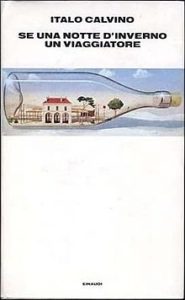 A book about reading. The novel opens with this line: “You are about to begin reading Italo Calvino’s new novel, If on a winter’s night a traveller.” Since the character “you” is a reader of the book, and you (yes, I mean you) are reading the book, it would appear that the fictional and actual readers are the same and this relationship is discussed in several chapters, further blurring the distinction between fiction and reality. Calvino’s book within a book, a mise en abyme, begins in the next chapter. The narrator is caught up in some sort of complex plot at a railroad station, but when the action starts to build, the novel is interrupted because of a printer’s error. You take it back to the bookstore where you meet a lovely young lady Ludmilla and the desire to talk to her about books motivates you to keep reading. This metafictional masterpiece then alternates between chapters explaining what you do to get ready to read the first chapters of books of various genres, which then influence the narrative of you and Ludmilla. What you end up with is one of the best, if not the most impressive, discussions of the act of reading in literature.
A book about reading. The novel opens with this line: “You are about to begin reading Italo Calvino’s new novel, If on a winter’s night a traveller.” Since the character “you” is a reader of the book, and you (yes, I mean you) are reading the book, it would appear that the fictional and actual readers are the same and this relationship is discussed in several chapters, further blurring the distinction between fiction and reality. Calvino’s book within a book, a mise en abyme, begins in the next chapter. The narrator is caught up in some sort of complex plot at a railroad station, but when the action starts to build, the novel is interrupted because of a printer’s error. You take it back to the bookstore where you meet a lovely young lady Ludmilla and the desire to talk to her about books motivates you to keep reading. This metafictional masterpiece then alternates between chapters explaining what you do to get ready to read the first chapters of books of various genres, which then influence the narrative of you and Ludmilla. What you end up with is one of the best, if not the most impressive, discussions of the act of reading in literature.
Link to Amazon
Card, Orson Scott. Ender’s Shadow. 1999.
 A parallel science fiction novel by the same author as the original, demonstrating how essential point of view is to the telling of a story and its meaning.
A parallel science fiction novel by the same author as the original, demonstrating how essential point of view is to the telling of a story and its meaning.
Link to Amazon
Cervantes, Miguel. Don Quixote. 1605.
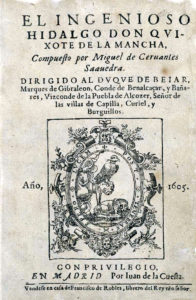 A book about books and the effects they have upon our minds and lives, especially when we try to live out our fictions in the real world. Cervantes challenges the notion of history and blurs the distinction between fiction and nonfiction. The novel is told through a series of authors nestled one within the other like Chinese boxes, which draws our attention to the ways in which stories are told and how each teller alters the tale. In the second volume, Don Quixote and Sancho Panza hear of the publication of the first and even meet a reader and talk to him about their own book! (Learn all about this great work, which began the two major genres of modern fiction, realism and metafiction, in my book Narrative Madness, check out my posts: In the Name of the Book, In the Name of Cervantes, Amen, Understanding is Making Up Stories about Chaos, Metafiction and Chaos Theory: Cory A. Reed’s “Chaotic Quixote”, To Understand, We Must Produce Narrative, Trapped in Narrative Language, When Don Quixote and Sancho Panza Hear of Their Book, La Mancha: The Stain of Truth, Who Wrote Don Quixote?, and How to Sound Like an Author of Great Learning and Eloquence: A Quixotic Preface.)
A book about books and the effects they have upon our minds and lives, especially when we try to live out our fictions in the real world. Cervantes challenges the notion of history and blurs the distinction between fiction and nonfiction. The novel is told through a series of authors nestled one within the other like Chinese boxes, which draws our attention to the ways in which stories are told and how each teller alters the tale. In the second volume, Don Quixote and Sancho Panza hear of the publication of the first and even meet a reader and talk to him about their own book! (Learn all about this great work, which began the two major genres of modern fiction, realism and metafiction, in my book Narrative Madness, check out my posts: In the Name of the Book, In the Name of Cervantes, Amen, Understanding is Making Up Stories about Chaos, Metafiction and Chaos Theory: Cory A. Reed’s “Chaotic Quixote”, To Understand, We Must Produce Narrative, Trapped in Narrative Language, When Don Quixote and Sancho Panza Hear of Their Book, La Mancha: The Stain of Truth, Who Wrote Don Quixote?, and How to Sound Like an Author of Great Learning and Eloquence: A Quixotic Preface.)
Online Edition / Link to Amazon
Chandler, Raymond. The Long Goodbye. 1953.
 In this Philip Marlowe detective story, a central character, Roger Wade, is a writer, which gives Chandler a chance to discuss writers and writing and the literary value of genre fiction. Like Chandler, Wade drinks heavily. He has had several successful novels under his belt but is finding it harder to write as he grows older. Wade writes romantic fiction, which, like Chandler’s mysteries, are undervalued by mainstream critics, but readers can see that Chandler is trying to transcend the genre to create a work of literary value (and he succeeds).
In this Philip Marlowe detective story, a central character, Roger Wade, is a writer, which gives Chandler a chance to discuss writers and writing and the literary value of genre fiction. Like Chandler, Wade drinks heavily. He has had several successful novels under his belt but is finding it harder to write as he grows older. Wade writes romantic fiction, which, like Chandler’s mysteries, are undervalued by mainstream critics, but readers can see that Chandler is trying to transcend the genre to create a work of literary value (and he succeeds).
Link to Amazon
Chaucer, Geoffrey. “The Prologue and Tale of Sir Thopas” and “The Prologue and Tale of Melibee.” Canterbury Tales. 1392.
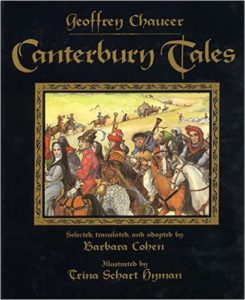 Yet another story about stories. In The Canterbury Tales, a character named Geoffrey Chaucer tells the worst tales in the book: first a romance about Sir Thopas with exaggerated rhythm and sophomoric rhymes, and then, when he is interrupted by the host, begins a boring and preachy story called “The Tale of Melibee,” loaded with pretentious quotes. Why does the author of the first truly great poem in the English language portray himself so badly? (I invite you to read my post: Chaucer: A Bad Poet and a Didactic Bore.)
Yet another story about stories. In The Canterbury Tales, a character named Geoffrey Chaucer tells the worst tales in the book: first a romance about Sir Thopas with exaggerated rhythm and sophomoric rhymes, and then, when he is interrupted by the host, begins a boring and preachy story called “The Tale of Melibee,” loaded with pretentious quotes. Why does the author of the first truly great poem in the English language portray himself so badly? (I invite you to read my post: Chaucer: A Bad Poet and a Didactic Bore.)
Online edition / Link to Amazon
Coetzee, J. M. Foe. 1986.
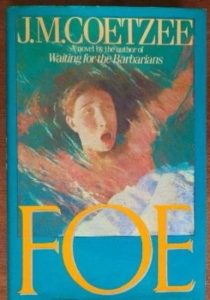 A retelling of a familiar story, emphasizing the importance of point of view in narrative and understanding. “Foe is written from the perspective of Susan Barton, a castaway who landed on the same island inhabited by “Cruso” and Friday as their adventures were already underway,” says Wikipedia.
A retelling of a familiar story, emphasizing the importance of point of view in narrative and understanding. “Foe is written from the perspective of Susan Barton, a castaway who landed on the same island inhabited by “Cruso” and Friday as their adventures were already underway,” says Wikipedia.
Link to Amazon
Coover, Robert. “Seven Exemplary Fictions.” Pricksongs and Descants: Fictions. 1969.
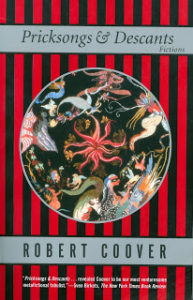 “Stories like Coover’s ‘The Babysitter’ (Pricksongs and Descants) . . . take the modernist conception of spatial form to logical conclusion. They offer a set of alternative stories as one story, which can be explained neither as happening simultaneously (because they can only be substitutions for each other) nor as happening in sequence (because they cannot be combined according to normal logic: they erase or cancel out each other,” argues Patricia Waugh in Metafiction: The Theory and Practice of Self Conscious Fiction. Includes: “Dedicatorio y Prologo a don Miguel de Cervantes Saavedra.” (I mention “Seven Exemplary Fictions” in my post The Danger of Meta: Pompidou and David Foster Wallace’s Octet.)
“Stories like Coover’s ‘The Babysitter’ (Pricksongs and Descants) . . . take the modernist conception of spatial form to logical conclusion. They offer a set of alternative stories as one story, which can be explained neither as happening simultaneously (because they can only be substitutions for each other) nor as happening in sequence (because they cannot be combined according to normal logic: they erase or cancel out each other,” argues Patricia Waugh in Metafiction: The Theory and Practice of Self Conscious Fiction. Includes: “Dedicatorio y Prologo a don Miguel de Cervantes Saavedra.” (I mention “Seven Exemplary Fictions” in my post The Danger of Meta: Pompidou and David Foster Wallace’s Octet.)
Link to Amazon
Cortázar, Julio. Hopscotch. 1963.
 “Look, any time an author feels that he has to include a “Table of Instructions” with his novel, you know it’s going to be pretty tricks-y. In this one, you also get multiple endings, sections from other novels of questionable veracity, and at least 99 “expendable” chapters. Get jumping,” says Emily Temple in “10 Phenomenally Tricky Books Everyone Should Read.”
“Look, any time an author feels that he has to include a “Table of Instructions” with his novel, you know it’s going to be pretty tricks-y. In this one, you also get multiple endings, sections from other novels of questionable veracity, and at least 99 “expendable” chapters. Get jumping,” says Emily Temple in “10 Phenomenally Tricky Books Everyone Should Read.”
Link to Amazon
Coupland, Douglas. JPod. 2006.
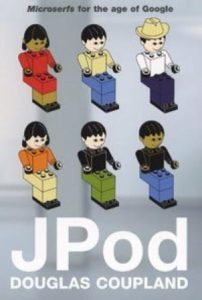 “Douglas Coupland, as a character, is inserted into the novel when Ethan visits China to bring a heroin-addicted Steve back to Canada. This Google-version of Douglas Coupland consistently bumps into Ethan and manages to weave himself into the narrator’s life. JPod finds itself in a digital world where technology is everything and the human mind is incapable of focusing on just one task,” according to Wikipedia.
“Douglas Coupland, as a character, is inserted into the novel when Ethan visits China to bring a heroin-addicted Steve back to Canada. This Google-version of Douglas Coupland consistently bumps into Ethan and manages to weave himself into the narrator’s life. JPod finds itself in a digital world where technology is everything and the human mind is incapable of focusing on just one task,” according to Wikipedia.
Link to Amazon
Cunningham, Michael. The Hours. 1999.
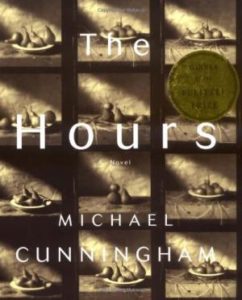 A book about books, a novel about the influence of Viriginia Woolf’s Mrs. Dalloway upon the lives of three generations of women: “The first is Woolf herself writing Mrs. Dalloway in 1923 and struggling with her own mental illness. The second is Mrs. Brown, wife of a World War II veteran, who is reading Mrs. Dalloway in 1949 as she plans her husband’s birthday party. The third is Clarissa Vaughan, a lesbian, who plans a party in 2001 to celebrate a major literary award received by her good friend and former lover, the poet Richard, who is dying of AIDS,” says Wikipedia.
A book about books, a novel about the influence of Viriginia Woolf’s Mrs. Dalloway upon the lives of three generations of women: “The first is Woolf herself writing Mrs. Dalloway in 1923 and struggling with her own mental illness. The second is Mrs. Brown, wife of a World War II veteran, who is reading Mrs. Dalloway in 1949 as she plans her husband’s birthday party. The third is Clarissa Vaughan, a lesbian, who plans a party in 2001 to celebrate a major literary award received by her good friend and former lover, the poet Richard, who is dying of AIDS,” says Wikipedia.
Link to Amazon
Danielwsi, Mark Z. House of Leaves. 2000.
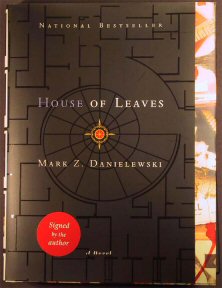 “The format and structure of the novel is unconventional, with unusual page layout and style, making it ergodic literature. It contains copious footnotes, many of which contain footnotes themselves, and some of which reference books that do not exist. Some pages contain only a few words or lines of text, arranged in strange ways to mirror the events in the story, often creating both an agoraphobic and a claustrophobic effect. The novel is also distinctive for its multiple narrators, who interact with each other throughout the story in disorienting and elaborate ways,” writes Wikipedia.
“The format and structure of the novel is unconventional, with unusual page layout and style, making it ergodic literature. It contains copious footnotes, many of which contain footnotes themselves, and some of which reference books that do not exist. Some pages contain only a few words or lines of text, arranged in strange ways to mirror the events in the story, often creating both an agoraphobic and a claustrophobic effect. The novel is also distinctive for its multiple narrators, who interact with each other throughout the story in disorienting and elaborate ways,” writes Wikipedia.
Link to Amazon
de Laclos, Pierre Choderlos. Les Liaisons Dangereuses. 1782.
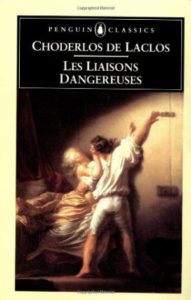 Told through letters, which normally makes events seem as though they really happened, except there is a preface that announces the book is a novel. The introduction by the fictional editor insists on the authenticity of the letters; his editorial presence throughout the book makes us aware that editors are in fact writers who reshape the material. All of these various editors are really just the author Laclos playing both sides of the game at once — metafiction and naturalism — challenging the distinctions between fiction and nonfiction, history and literature. (Check out my post: Dangerous Editors: Coderlos de Laclos’ Les Liaisons Dangereuses.)
Told through letters, which normally makes events seem as though they really happened, except there is a preface that announces the book is a novel. The introduction by the fictional editor insists on the authenticity of the letters; his editorial presence throughout the book makes us aware that editors are in fact writers who reshape the material. All of these various editors are really just the author Laclos playing both sides of the game at once — metafiction and naturalism — challenging the distinctions between fiction and nonfiction, history and literature. (Check out my post: Dangerous Editors: Coderlos de Laclos’ Les Liaisons Dangereuses.)
Link to Amazon
de Unamuno, Miguel. Mist: A Tragicomic Novel. 1914.
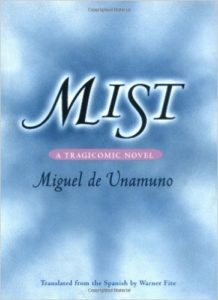 “Augusto, heartbroken, decides to kill himself. However, because everything he does involves a lengthy thought process, he decides that he needs to consult Unamuno himself (the author of the novel), who had written an article on suicide which Augusto had read. When Augusto speaks with Unamuno, the truth is revealed that Augusto is actually a fictional character whom Unamuno has created. Augusto is not real, Unamuno explains, and for that reason cannot kill himself. Augusto asserts that he exists, even though he acknowledges internally that he doesn’t, and threatens Unamuno by telling him that he is not the ultimate author. Augusto reminds Unamuno that he might be just one of God’s dreams,” says Wikipedia.
“Augusto, heartbroken, decides to kill himself. However, because everything he does involves a lengthy thought process, he decides that he needs to consult Unamuno himself (the author of the novel), who had written an article on suicide which Augusto had read. When Augusto speaks with Unamuno, the truth is revealed that Augusto is actually a fictional character whom Unamuno has created. Augusto is not real, Unamuno explains, and for that reason cannot kill himself. Augusto asserts that he exists, even though he acknowledges internally that he doesn’t, and threatens Unamuno by telling him that he is not the ultimate author. Augusto reminds Unamuno that he might be just one of God’s dreams,” says Wikipedia.
Link to Amazon
Dick, Phillip K. Radio Free Albemuth. 1976.
“As with its successor, VALIS, this novel is autobiographical. Dick himself is a major character,” according to Wikipedia.
Link to Amazon
–. VALIS. 1981.
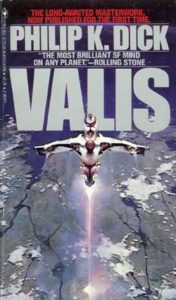 “The main character in VALIS is Horselover Fat, an author surrogate. “Horselover” echoes the Greek etymology of the name Philip, while in German, Dick’s surname means ‘fat’. Dick, as narrator, states early in the book that the creation of the character ‘Horselover Fat’ is to allow him some ‘much needed objectivity.’ In this particular work the narrator is also a fictional character provided as a cool, pragmatic counter-point to Horselover’s slow disintegration. Even though the book is written in the first-person-autobiographical, for most of the book Dick treats himself and Fat as two separate characters; he describes conversations and arguments with Fat, and harshly if sympathetically criticizes his opinions and writings,” writes Wikipedia.
“The main character in VALIS is Horselover Fat, an author surrogate. “Horselover” echoes the Greek etymology of the name Philip, while in German, Dick’s surname means ‘fat’. Dick, as narrator, states early in the book that the creation of the character ‘Horselover Fat’ is to allow him some ‘much needed objectivity.’ In this particular work the narrator is also a fictional character provided as a cool, pragmatic counter-point to Horselover’s slow disintegration. Even though the book is written in the first-person-autobiographical, for most of the book Dick treats himself and Fat as two separate characters; he describes conversations and arguments with Fat, and harshly if sympathetically criticizes his opinions and writings,” writes Wikipedia.
Link to Amazon
Dickens, Charles. Bleak House. 1852-1853.
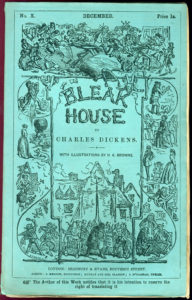 The world of Bleak House is dripping with ink. Dickens novel is a book about texts and the interpretation of texts. (Read my post about the metafictional elements in the novel: Meta Bleak House.)
The world of Bleak House is dripping with ink. Dickens novel is a book about texts and the interpretation of texts. (Read my post about the metafictional elements in the novel: Meta Bleak House.)
Online Edition / Link to Amazon
Durrell, Lawrence. Alexandria Quartet. 1957, 1958, 1958, 1960.
 Same story told from different perspectives, highlighting the importance of point of view to perception and meaning.
Same story told from different perspectives, highlighting the importance of point of view to perception and meaning.
Link to Amazon
Eco, Umberto. The Name of the Rose. 1980.
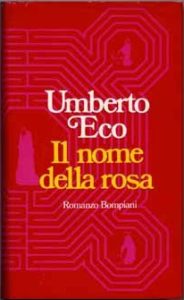 Umberto Eco, in this erudite mystery, set in an Italian monastery in 1327, compares the investigation of a murder with religious, scholarly and philosophical inquiry. The book is metafictional because it is a book about how we read and how we learn and how our institutes control knowledge and philosophy by controlling access to books. Eco poses a question: What if the serious bent we have in our colleges and literature (since we still value drama over comedy) was the result of a historical manipulation?
Umberto Eco, in this erudite mystery, set in an Italian monastery in 1327, compares the investigation of a murder with religious, scholarly and philosophical inquiry. The book is metafictional because it is a book about how we read and how we learn and how our institutes control knowledge and philosophy by controlling access to books. Eco poses a question: What if the serious bent we have in our colleges and literature (since we still value drama over comedy) was the result of a historical manipulation?
Link to Amazon
Ellis, Bret Easton. American Psycho. 1991.
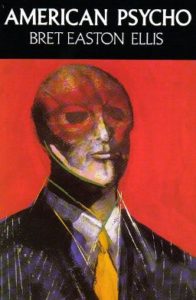 “Bateman has, we may well conclude, done nothing but write, speak, construct himself in a variety of language games, none of which is any more ‘real’ than the others. Has he really killed anybody at all? . . . All we can say for sure is that Patrick Bateman is, precisely, a fiction. In fact, Bateman’s fictionality is of the highest self-consciousness, and suggest an aggravated dance between him and Ellis himself, a shifting power relation between author and narrator, which is of the highest order of interest theoretically,” said Julian Murphet in and interview with Eileen Battersby, Irish Times, Feb. 25, 1999. (49-50).
“Bateman has, we may well conclude, done nothing but write, speak, construct himself in a variety of language games, none of which is any more ‘real’ than the others. Has he really killed anybody at all? . . . All we can say for sure is that Patrick Bateman is, precisely, a fiction. In fact, Bateman’s fictionality is of the highest self-consciousness, and suggest an aggravated dance between him and Ellis himself, a shifting power relation between author and narrator, which is of the highest order of interest theoretically,” said Julian Murphet in and interview with Eileen Battersby, Irish Times, Feb. 25, 1999. (49-50).
Link to Amazon
Lunar Park. 2005.
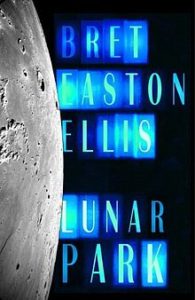 “Lunar Park, then, is rife with doubles and doubling. There is a doubling of voices (the ‘I’ ambiguously referring to the author and/or the character) and there is a doubling of the reader’s reading strategies (reading the book as at once fictional and nonfictional). Within the text, doubles abound (Clayton, for examples, functions as one of Bret’s doppelgänger; the house on Elsinore Lane, where Brett, and Ellis, grew up). The figure of the writer is also doubled when the author makes an appearance,” writes Naomi Mandel in Bret Easton Ellis in American Psycho, Glamorama, and Lunar Park.
“Lunar Park, then, is rife with doubles and doubling. There is a doubling of voices (the ‘I’ ambiguously referring to the author and/or the character) and there is a doubling of the reader’s reading strategies (reading the book as at once fictional and nonfictional). Within the text, doubles abound (Clayton, for examples, functions as one of Bret’s doppelgänger; the house on Elsinore Lane, where Brett, and Ellis, grew up). The figure of the writer is also doubled when the author makes an appearance,” writes Naomi Mandel in Bret Easton Ellis in American Psycho, Glamorama, and Lunar Park.
Link to Amazon
Ende, Michael. The Neverending Story. 1983.
 A novel about a boy named Bastian Balthazar Bux reading and interacting with a novel. The act of reading becomes an act of creation, as the book responds to things he says and thinks and does, blurring the lines between fiction and reality. The boy eventually recognizes that he is the main character in the book within a book, whose quest is to prevent the nothingness from wiping out everything. The nothing represents a growing lack of imagination in the modern world, where stories are prepared and packaged for modern consumers so that readers do not have to use their own imaginations. The main character saves the fictional world and his own by bringing his imagination to life.
A novel about a boy named Bastian Balthazar Bux reading and interacting with a novel. The act of reading becomes an act of creation, as the book responds to things he says and thinks and does, blurring the lines between fiction and reality. The boy eventually recognizes that he is the main character in the book within a book, whose quest is to prevent the nothingness from wiping out everything. The nothing represents a growing lack of imagination in the modern world, where stories are prepared and packaged for modern consumers so that readers do not have to use their own imaginations. The main character saves the fictional world and his own by bringing his imagination to life.
Link to Amazon
Fowles, John. The French Lieutenant’s Woman. 1969.
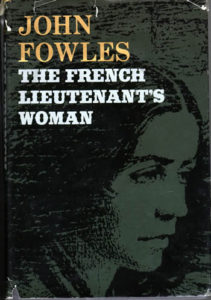 “The novel is set in the nineteenth Century romantic literary genre with the plot of 1867 seen through a twentieth century perspective. It deals with the love story of Sarah Woodruff and Charles Smithson, a paleontologist and follower of Darwin. . . . The given novel The French Lieutenant’s Woman is not a fiction that presents the illusion of reality as an actual experience. Instead, it is a meta-fiction that makes the readers aware of the illusion. . . . It makes the structure and creation of the novel as important a feature as its story telling capabilities by calling attention to itself. On account of such innovative style, readers see the novel as a piece of imagination having nothing to do with the immediate reality,” according to bachelorandmaster.com. Link to Amazon
“The novel is set in the nineteenth Century romantic literary genre with the plot of 1867 seen through a twentieth century perspective. It deals with the love story of Sarah Woodruff and Charles Smithson, a paleontologist and follower of Darwin. . . . The given novel The French Lieutenant’s Woman is not a fiction that presents the illusion of reality as an actual experience. Instead, it is a meta-fiction that makes the readers aware of the illusion. . . . It makes the structure and creation of the novel as important a feature as its story telling capabilities by calling attention to itself. On account of such innovative style, readers see the novel as a piece of imagination having nothing to do with the immediate reality,” according to bachelorandmaster.com. Link to Amazon
Gaardner, Jostein. Sophie’s World: A Novel about the History of Philosophy. 1991.
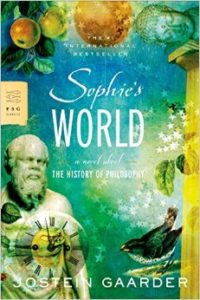 Contains a novel within a novel (a mise en abyme). (To read more about mise en abyme, a typical metafictional convention, see my post The Mirror in the Text, Part II: Mise en Abyme.)
Contains a novel within a novel (a mise en abyme). (To read more about mise en abyme, a typical metafictional convention, see my post The Mirror in the Text, Part II: Mise en Abyme.)
Link to Amazon
Gardner, John. Grendel. 1971.
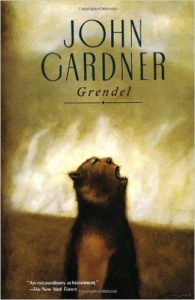 A total reinvention of Beowulf, one of English’s earliest and greatest epics. Told from the monster’s perspective, our sympathies are flipped around, showing how easily point of view can manipulate our judgment.
A total reinvention of Beowulf, one of English’s earliest and greatest epics. Told from the monster’s perspective, our sympathies are flipped around, showing how easily point of view can manipulate our judgment.
Link to Amazon
Gass, William H. “In the Heart of the Heart of the Country.” In the Heart of the Heart of the Country & Other Stories. 1968.
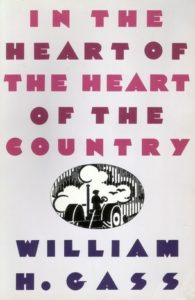 A metafictional short story by the man who named “metafiction.” (Mentioned in my post The Danger of Meta: Pompidou and David Foster Wallace’s Octet.)
A metafictional short story by the man who named “metafiction.” (Mentioned in my post The Danger of Meta: Pompidou and David Foster Wallace’s Octet.)
Link to Amazon
–. Willie Masters’ Lonesome Wife. 1968.
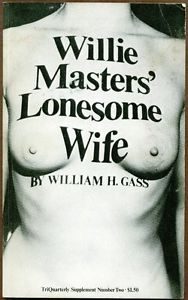 “A book in which the book itself seeks interaction with the reader,” according to Wikipedia. “An experimental novella illustrated with photographs and typographical constructs intended to help readers free themselves from the linear conventions of narrative,” writes Wikipedia.
“A book in which the book itself seeks interaction with the reader,” according to Wikipedia. “An experimental novella illustrated with photographs and typographical constructs intended to help readers free themselves from the linear conventions of narrative,” writes Wikipedia.
Link to Amazon
Gide, Andre. The Counterfeiters. 1925.
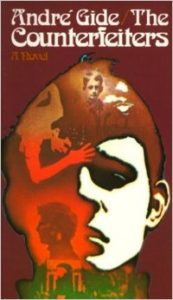 The Counterfeiters is not so much a novel within a novel, but a novel of the production of a novel. Gide, who invented the literary term, mise en abyme (a novel within a novel, a play inside a play, a painting in a painting) uses the device to examine writing and its relationship to reality. (Read my posts: The Mirror in the Text, Part I: The Counterfeiters, The Mirror in the Text: Part II: Mise en Abyme, The Mirror in the Text, Part III: The Mirror in the Text.)
The Counterfeiters is not so much a novel within a novel, but a novel of the production of a novel. Gide, who invented the literary term, mise en abyme (a novel within a novel, a play inside a play, a painting in a painting) uses the device to examine writing and its relationship to reality. (Read my posts: The Mirror in the Text, Part I: The Counterfeiters, The Mirror in the Text: Part II: Mise en Abyme, The Mirror in the Text, Part III: The Mirror in the Text.)
Link to Amazon
Goldman, William. The Princess Bride: S. Morgenstern’s Classic Tale of True Love and High Adventure. 1973.
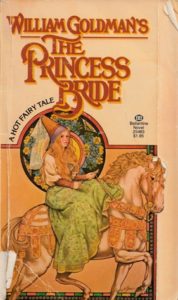 This novel is a novel about reading a novel — or at least the good parts. The first line reads, “This is my favorite book in all the world, though I have never read it.” The narrator is supposedly William Goldman himself but is a fictionalized version, reflecting back on his childhood at a time when he did not like reading. Once when he was sick, his father began reading the best parts of a long novel by S. Morgenstern to him. The adult narrator, his younger self, and his father continually comment on and interact with the novel, demonstrating the power of fiction to delight and enlighten. The narrator claims not to have added any scenes except a reunion scene between Westley and Buttercup, which the publisher would not allow him to include, so he invites readers to write the publisher and ask for the scene. Those who did so received a letter explaining legal issues with the Morgenstern estate, which has been repeatedly updated. The metafiction, therefore, continues well beyond the novel.
This novel is a novel about reading a novel — or at least the good parts. The first line reads, “This is my favorite book in all the world, though I have never read it.” The narrator is supposedly William Goldman himself but is a fictionalized version, reflecting back on his childhood at a time when he did not like reading. Once when he was sick, his father began reading the best parts of a long novel by S. Morgenstern to him. The adult narrator, his younger self, and his father continually comment on and interact with the novel, demonstrating the power of fiction to delight and enlighten. The narrator claims not to have added any scenes except a reunion scene between Westley and Buttercup, which the publisher would not allow him to include, so he invites readers to write the publisher and ask for the scene. Those who did so received a letter explaining legal issues with the Morgenstern estate, which has been repeatedly updated. The metafiction, therefore, continues well beyond the novel.
Link to Amazon
Gray, Alisdair. Lanark: A Life in Four Books. 1981.
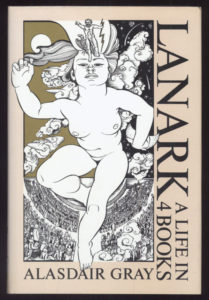 “Gray’s modern interpretation of hell is organized into four books, which are arranged in the following order: Three, One, Two, Four. There’s also an epilogue about four chapters shy of the end of the book, in which the author explains, “I want Lanark to be read in one order but eventually thought of in another.” Part realist, part fantasist, all genius, we highly recommend you read this book,” writesEmily Temple in “10 Phenomenally Tricky Books Everyone Should Read.” “One of the most characteristically postmodern parts of the book is the Epilogue, in which Lanark meets the author in the guise of the character ‘Nastler’. He . . . anticipates criticism of the work and of the Epilogue in particular, saying ‘The critics will accuse me of self-indulgence, but I don’t care’. An Index of Plagiarisms is printed in the margins of the discussion. For instance, Gray describes much of Lanark as an extended ‘Difplag’ (diffuse plagiarism) of Charles Kingsley’s The Water Babies. However, some of the supposed plagiarisms refer to non-existent chapters of the book,” says Wikipedia.
“Gray’s modern interpretation of hell is organized into four books, which are arranged in the following order: Three, One, Two, Four. There’s also an epilogue about four chapters shy of the end of the book, in which the author explains, “I want Lanark to be read in one order but eventually thought of in another.” Part realist, part fantasist, all genius, we highly recommend you read this book,” writesEmily Temple in “10 Phenomenally Tricky Books Everyone Should Read.” “One of the most characteristically postmodern parts of the book is the Epilogue, in which Lanark meets the author in the guise of the character ‘Nastler’. He . . . anticipates criticism of the work and of the Epilogue in particular, saying ‘The critics will accuse me of self-indulgence, but I don’t care’. An Index of Plagiarisms is printed in the margins of the discussion. For instance, Gray describes much of Lanark as an extended ‘Difplag’ (diffuse plagiarism) of Charles Kingsley’s The Water Babies. However, some of the supposed plagiarisms refer to non-existent chapters of the book,” says Wikipedia.
Link to Amazon
Green, Geoffrey. Voices in a Mask. 2008.
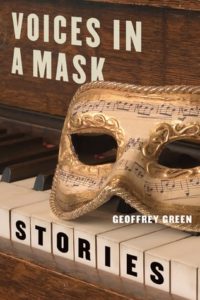 Short stories composed around the theme of opera, in particular, Don Juan. The book encourages readers to play the appropriate operas as they read and perform the text, thereby emphasizing the importance of the reader to recreate or rewrite the text. “The first narrator provides an Overture, addressing an audience as though onstage; though the point of view changes, the stiff language and frequent use of exclamation points are signs of things to come,” writes Publishers Weekly.
Short stories composed around the theme of opera, in particular, Don Juan. The book encourages readers to play the appropriate operas as they read and perform the text, thereby emphasizing the importance of the reader to recreate or rewrite the text. “The first narrator provides an Overture, addressing an audience as though onstage; though the point of view changes, the stiff language and frequent use of exclamation points are signs of things to come,” writes Publishers Weekly.
Link to Amazon
Grudin, Robert. Book: A Novel. 1992.
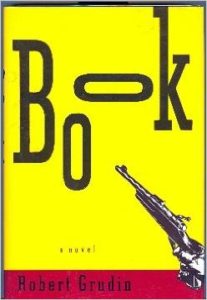 The title itself is self-referential and the book contains a mise en abyme, a book within a book. “The story follows English professor Adam Snell as he realizes that someone is trying to kill both him and his book, Sovrana Sostrata, a book about truth. As a metafiction work the novel parodies literary forms—each chapter is told in a different style ranging from traditional linear drama, to newspaper reports, to a playwright’s script, to a carefully annotated scholarly work from the 19th Century—to the point where the novel’s footnotes come alive and literally try to take over the narrative,” says Wikipedia. (To read more about mise en abyme, a typical metafictional convention, see my post The Mirror in the Text, Part II: Mise en Abyme.)
The title itself is self-referential and the book contains a mise en abyme, a book within a book. “The story follows English professor Adam Snell as he realizes that someone is trying to kill both him and his book, Sovrana Sostrata, a book about truth. As a metafiction work the novel parodies literary forms—each chapter is told in a different style ranging from traditional linear drama, to newspaper reports, to a playwright’s script, to a carefully annotated scholarly work from the 19th Century—to the point where the novel’s footnotes come alive and literally try to take over the narrative,” says Wikipedia. (To read more about mise en abyme, a typical metafictional convention, see my post The Mirror in the Text, Part II: Mise en Abyme.)
Link to Amazon
Haddon, Mark. The Curious Incident of the Dog in the Night-Time. 2003.
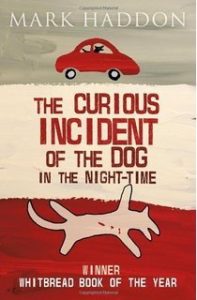 A novel about a writer writing a story: “Throughout his adventures, Christopher records his experiences in a book: a ‘murder mystery novel,’ says Wikipedia, which makes the novel within a novel a mise en abyme. (To read more about mise en abyme, see my post The Mirror in the Text, Part II: Mise en Abyme.)
A novel about a writer writing a story: “Throughout his adventures, Christopher records his experiences in a book: a ‘murder mystery novel,’ says Wikipedia, which makes the novel within a novel a mise en abyme. (To read more about mise en abyme, see my post The Mirror in the Text, Part II: Mise en Abyme.)
Link to Amazon
Hess, Herman. Steppenwolf. 1927.
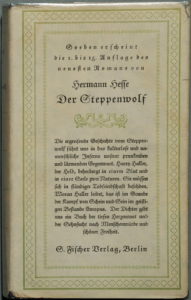 “In the extended stage setting preface, the narrator describes Haller and then laments that he got too carried away in the description, and ended up disclosing more than he wanted to the reader, thus, subtly confessing to the reader that there is a reader and there is a writer, and such is the frankness and the directness of the communication between them that the writer is not willing to go back and tear away a page which he has written contrary to his plan” (from PS: Elements of Metafiction in Steppenwolf).
“In the extended stage setting preface, the narrator describes Haller and then laments that he got too carried away in the description, and ended up disclosing more than he wanted to the reader, thus, subtly confessing to the reader that there is a reader and there is a writer, and such is the frankness and the directness of the communication between them that the writer is not willing to go back and tear away a page which he has written contrary to his plan” (from PS: Elements of Metafiction in Steppenwolf).
Online Edition / Link to Amazon
Homer. The Illiad . c. 750 B.C.
Online Edition / Link to Amazon
–. The Odyssey. c. 750 B.C.
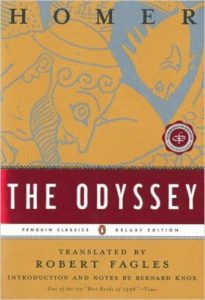 These epics which form the foundation of western literature include scenes in which bards sing their works, a self-referential presentation of how the epics were themselves presented, a kind of epic inside an epic, another example of a mise en abyme. (To read more about mise en abyme, see my post The Mirror in the Text, Part II: Mise en Abyme. Read my related post: The Early History of Metafiction.)
These epics which form the foundation of western literature include scenes in which bards sing their works, a self-referential presentation of how the epics were themselves presented, a kind of epic inside an epic, another example of a mise en abyme. (To read more about mise en abyme, see my post The Mirror in the Text, Part II: Mise en Abyme. Read my related post: The Early History of Metafiction.)
Online Edition / Link to Amazon
Hofstadter, Douglas. Godel, Escher, Bach: An Eternal Golden Braid. 1979.
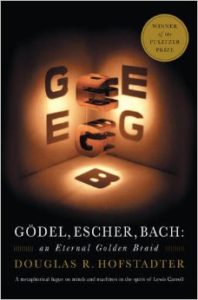 Includes a “dialogue between two characters who interact within the dialogue with the author himself, who enters the dialogue he is writing as a character created by him,” says Webster Online Dictionary.
Includes a “dialogue between two characters who interact within the dialogue with the author himself, who enters the dialogue he is writing as a character created by him,” says Webster Online Dictionary.
Link to Amazon
Irving, John. The World According to Garp. 1978.
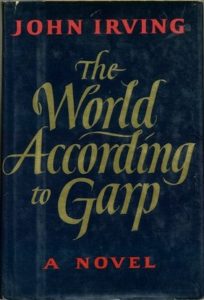 Fiction with several pieces of fiction inside itself, examples of mise en abyme. “The novel contains several framed narratives: Garp’s first novella, The Pension Grillparzer; a short story; and a portion of one of his novels, The World According to Bensenhaver,” according to Wikipedia.
Fiction with several pieces of fiction inside itself, examples of mise en abyme. “The novel contains several framed narratives: Garp’s first novella, The Pension Grillparzer; a short story; and a portion of one of his novels, The World According to Bensenhaver,” according to Wikipedia.
Link to Amazon
Johnson, B. S. Albert Angelo. 1964.
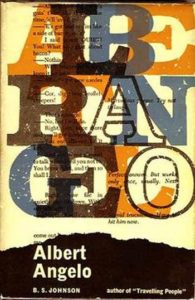 “There are holes in the pages of Albert Angelo. No, literally — there’s also columned text, split between dialogue and the internal thoughts of the protagonist. Parts read like a play. There are ads. There are multiple narrative viewpoints. Tricks may abound, but good luck following the rabbit through the top hat’s false bottom,” writes Emily Temple in “10 Phenomenally Tricky Books Everyone Should Read.”
“There are holes in the pages of Albert Angelo. No, literally — there’s also columned text, split between dialogue and the internal thoughts of the protagonist. Parts read like a play. There are ads. There are multiple narrative viewpoints. Tricks may abound, but good luck following the rabbit through the top hat’s false bottom,” writes Emily Temple in “10 Phenomenally Tricky Books Everyone Should Read.”
Link to Amazon
Johnson, Crockett. Harold and the Purple Crayon. 1955.
 Johnson’s book is metafictional because it shows us how an artist creates a drawing, laying bare the process of its creation. Harold, the main character, creates his own world by drawing it; therefore, he is the illustrator of his own book. (Check out my post “A Nightmare Reading of Harold and the Purple Crayon.”)
Johnson’s book is metafictional because it shows us how an artist creates a drawing, laying bare the process of its creation. Harold, the main character, creates his own world by drawing it; therefore, he is the illustrator of his own book. (Check out my post “A Nightmare Reading of Harold and the Purple Crayon.”)
Link to Amazon
Joyce, James. Finnegans Wake. 1939.
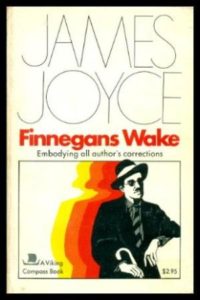 One of the most metafictional work of all time: a story about a story that is repeated endlessly: the rise and fall of humanity. Joyce essentially invented his own mishmash of languages, making the book notoriously difficult to read, but if you drink several glasses of whiskey, smoke a few bowls, occasionally refer to a guide, and think of the novel as a great collection of puns, the book becomes more readable, even funny. In the middle of the book, we get a chapter with margin notes and footnotes, a common convention in metafiction, but these notes do little to help us understand. One says, “Menly about peebles.” Another note is a bar of music with rising and falling notes. (Read my post: Hisstory Repleats Herself: James Joyce’s Finnegan’s Wake.)
One of the most metafictional work of all time: a story about a story that is repeated endlessly: the rise and fall of humanity. Joyce essentially invented his own mishmash of languages, making the book notoriously difficult to read, but if you drink several glasses of whiskey, smoke a few bowls, occasionally refer to a guide, and think of the novel as a great collection of puns, the book becomes more readable, even funny. In the middle of the book, we get a chapter with margin notes and footnotes, a common convention in metafiction, but these notes do little to help us understand. One says, “Menly about peebles.” Another note is a bar of music with rising and falling notes. (Read my post: Hisstory Repleats Herself: James Joyce’s Finnegan’s Wake.)
Link to Amazon: The Novel / Link to Amazon: A Reader’s Guide
–. A Portrait of the Artist as a Young Man. 1916.
 This semi-autobiographical novel is a reflection on the formation of an artist and the relationship between artist, art and life.
This semi-autobiographical novel is a reflection on the formation of an artist and the relationship between artist, art and life.
Link to Amazon
–. Ulysses. 1918-1920.
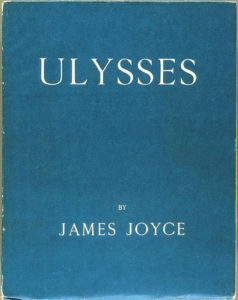 A book of books. First of all, the book parallels Homer’s Odyssey, pulling this foundational text of western literature into the world of Dublin in the early twentieth century. Secondly, the book strives to be a book of all books, a compendium of nearly every imaginable type of text, including: fiction, poetry, song, theatrical script (including stage directions), romance magazine and novelette, newspaper article, advertisement, correspondence, legal document, encyclopedia, mythology, biblical text, catechism, pun, parody, monologue and free indirect discourse. One chapter recreates the history of the English language in literature, moving from prose heavily influenced by Latin up to modern slang. (Another highly fictional work by Joyce is Finnegan’s Wake. Read my post Hisstory Repleats Herself: James Joyce’s Finnegan’s Wake.)
A book of books. First of all, the book parallels Homer’s Odyssey, pulling this foundational text of western literature into the world of Dublin in the early twentieth century. Secondly, the book strives to be a book of all books, a compendium of nearly every imaginable type of text, including: fiction, poetry, song, theatrical script (including stage directions), romance magazine and novelette, newspaper article, advertisement, correspondence, legal document, encyclopedia, mythology, biblical text, catechism, pun, parody, monologue and free indirect discourse. One chapter recreates the history of the English language in literature, moving from prose heavily influenced by Latin up to modern slang. (Another highly fictional work by Joyce is Finnegan’s Wake. Read my post Hisstory Repleats Herself: James Joyce’s Finnegan’s Wake.)
Link to Amazon
King, Stephen. The Dark Half. 1989.
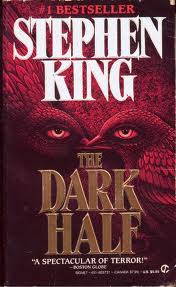 “Stephen King wrote several books under a pseudonym, Richard Bachman, during the seventies and eighties. Most of the Bachman novels were darker and more cynical in nature, featuring a far more visceral sense of horror than the psychological, gothic style common to many of King’s most famous works. When King was discovered to be Bachman, he wrote The Dark Half in response to his outing. Thad Beaumont is an author and recovering alcoholic who lives in the town of Ludlow, Maine. Thad’s own books – cerebral literary fiction – are not very successful. However, under the pen name “George Stark”, he writes highly successful crime novels about a violent killer named Alexis Machine. When Thad’s authorship of Stark’s novels becomes public knowledge, Thad and his wife, Elizabeth, decide to stage a mock funeral for his alter ego during a People magazine photo shoot. His epitaph at the local cemetery says it all: ‘Not A Very Nice Guy. Stark, however, emerges as a physical entity and goes on a killing spree, gruesomely murdering everyone he perceives responsible for his ‘death,'” says Wikipedia. Link to Amazon
“Stephen King wrote several books under a pseudonym, Richard Bachman, during the seventies and eighties. Most of the Bachman novels were darker and more cynical in nature, featuring a far more visceral sense of horror than the psychological, gothic style common to many of King’s most famous works. When King was discovered to be Bachman, he wrote The Dark Half in response to his outing. Thad Beaumont is an author and recovering alcoholic who lives in the town of Ludlow, Maine. Thad’s own books – cerebral literary fiction – are not very successful. However, under the pen name “George Stark”, he writes highly successful crime novels about a violent killer named Alexis Machine. When Thad’s authorship of Stark’s novels becomes public knowledge, Thad and his wife, Elizabeth, decide to stage a mock funeral for his alter ego during a People magazine photo shoot. His epitaph at the local cemetery says it all: ‘Not A Very Nice Guy. Stark, however, emerges as a physical entity and goes on a killing spree, gruesomely murdering everyone he perceives responsible for his ‘death,'” says Wikipedia. Link to Amazon
–. Song of Susannah. 2004.
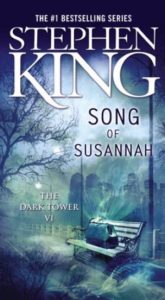 The author appears a character! “As a postscriptum, the reader becomes familiar with the diary of Stephen King the character which encompasses the period from 1977 to 1999. The diary details King’s writing of the first five books of the Dark Tower story. It is said that the character, Stephen King, dies on June 19, 1999,” according to Wikipedia.
The author appears a character! “As a postscriptum, the reader becomes familiar with the diary of Stephen King the character which encompasses the period from 1977 to 1999. The diary details King’s writing of the first five books of the Dark Tower story. It is said that the character, Stephen King, dies on June 19, 1999,” according to Wikipedia.
Link to Amazon
–. Misery. 1987.
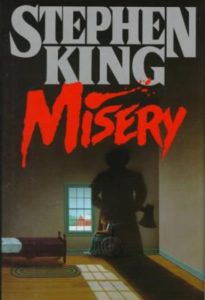 A novel about the complex and sometimes problematic relationships writers have with their fans, who expect them to keep producing the same kinds of books that they love. Paul Sheldon, a writer of Victorian romances, is rescued from a car wreck by his “number one fan,” Annie Wilkes. She becomes his number one critic when she reads the newest novel in his romance series about Misery Chastain, but when she learns that he has killed off the heroine at the end of the book (so that he could move on to other projects and become a mainstream writer), she is begin writing a new Misery novel in which the heroine is resurrected. Ultimately, Misery is a novel about writing a novel and readers get to see the inner workings of an author’s mind, albeit under extreme (and often bloody) circumstances.
A novel about the complex and sometimes problematic relationships writers have with their fans, who expect them to keep producing the same kinds of books that they love. Paul Sheldon, a writer of Victorian romances, is rescued from a car wreck by his “number one fan,” Annie Wilkes. She becomes his number one critic when she reads the newest novel in his romance series about Misery Chastain, but when she learns that he has killed off the heroine at the end of the book (so that he could move on to other projects and become a mainstream writer), she is begin writing a new Misery novel in which the heroine is resurrected. Ultimately, Misery is a novel about writing a novel and readers get to see the inner workings of an author’s mind, albeit under extreme (and often bloody) circumstances.
Link to Amazon
–. “Secret Window, Secret Garden.” Four Past Midnight. 1990.
 A novella about a novelist writing a novel. Mort Rainey is a thinly veiled stand-in for the author himself.
A novella about a novelist writing a novel. Mort Rainey is a thinly veiled stand-in for the author himself.
Link to Amazon
Kostova, Elizabeth. The Historian. 2005.
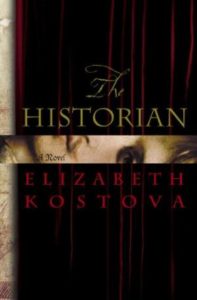 The Historian “blends the history and folklore of Vlad Ţepeş and his fictional equivalent Count Dracula. . . . Although based in part on Bram Stoker’s Dracula, The Historian is not a horror novel, but rather an eerie tale. It is concerned with history’s role in society and representation in books, as well as the nature of good and evil,” writes Wikipedia.
The Historian “blends the history and folklore of Vlad Ţepeş and his fictional equivalent Count Dracula. . . . Although based in part on Bram Stoker’s Dracula, The Historian is not a horror novel, but rather an eerie tale. It is concerned with history’s role in society and representation in books, as well as the nature of good and evil,” writes Wikipedia.
Link to Amazon
Kung, Dinah Lee. A Visit from Voltaire. 2004.
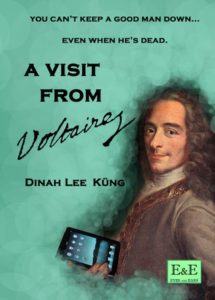 “The author/narrator spends the entire book comparing life notes with an author-ghost from another era,” says Wikipedia.
“The author/narrator spends the entire book comparing life notes with an author-ghost from another era,” says Wikipedia.
Link to Amazon
Lewis, C. S. Till We Have Faces: A Myth Retold. 1956.
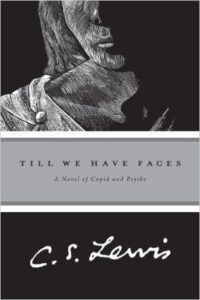 A “retelling of the Greek myth of Cupid and Psyche, which had haunted Lewis all his life, and which is itself based on a chapter of The Golden Ass of Apuleius,” according to freebooks4u.net.
A “retelling of the Greek myth of Cupid and Psyche, which had haunted Lewis all his life, and which is itself based on a chapter of The Golden Ass of Apuleius,” according to freebooks4u.net.
Online edition / Link to Amazon
Maguire, Gregory. Wicked: The Life and Times of the Wicked Witch of the West. 1995.
 The familiar story of the wizard of oz turned inside out as it is told from the green witch’s perspective. Maybe she wasn’t so bad after all. Maybe the false wizard was worse than the real witch.
The familiar story of the wizard of oz turned inside out as it is told from the green witch’s perspective. Maybe she wasn’t so bad after all. Maybe the false wizard was worse than the real witch.
Link to Amazon
McEwan, Ian. Atonement: A Novel. 2001.
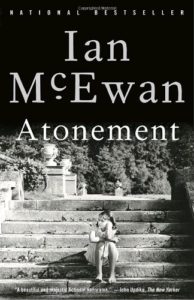 A novel about a writer writing a novel. “This is an example of modern metafiction: the book you are reading and physically holding in your hands, the one written by the author named on the cover, turns out at the end to have been ‘written’ by one of the characters named in the novel. Why should anyone do this? . . . It seems to me that the point of a novel within a novel, or a narrative within a narrative, is that the story becomes framed by the reader’s expectations. By putting what appears to be the ‘hot’ narrative of a real novel inside the ‘cooler’ context of a frame, making it into a told story or a found account, the author (i.e. the real one, named on the cover) is distancing the reader from the subject matter, an invitation to think while reading,” writes Christopher Priest in Review of Atonement.
A novel about a writer writing a novel. “This is an example of modern metafiction: the book you are reading and physically holding in your hands, the one written by the author named on the cover, turns out at the end to have been ‘written’ by one of the characters named in the novel. Why should anyone do this? . . . It seems to me that the point of a novel within a novel, or a narrative within a narrative, is that the story becomes framed by the reader’s expectations. By putting what appears to be the ‘hot’ narrative of a real novel inside the ‘cooler’ context of a frame, making it into a told story or a found account, the author (i.e. the real one, named on the cover) is distancing the reader from the subject matter, an invitation to think while reading,” writes Christopher Priest in Review of Atonement.
Link to Amazon
Mitchell, David. Cloud Atlas. 2004.
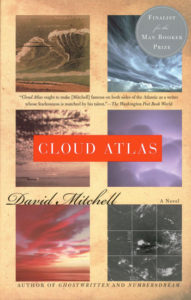 “David Mitchell’s masterpiece is frequently described as a literary version of Russian nesting dolls, and in a way it is — one part of the novel exists as a manuscript in another, and the same lilting refrain, the eponymous sextet, drifts throughout. But more aptly, these are interlocked novellas, each one feeding off the others, building towards an examination of the world as we know it,” argues Emily Temple in “10 Phenomenally Tricky Books Everyone Should Read.”
“David Mitchell’s masterpiece is frequently described as a literary version of Russian nesting dolls, and in a way it is — one part of the novel exists as a manuscript in another, and the same lilting refrain, the eponymous sextet, drifts throughout. But more aptly, these are interlocked novellas, each one feeding off the others, building towards an examination of the world as we know it,” argues Emily Temple in “10 Phenomenally Tricky Books Everyone Should Read.”
Link to Amazon
Moer, Walter. The City of Dreaming Books. 2004.
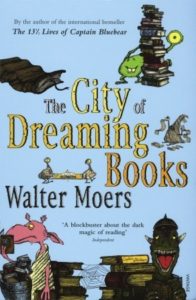 “The narrator and author gives the reader a warning about going too far into the story without being strong of heart or spirit, and most of the tale takes place in a city focused around the glorification of books and writers,” writes Joyce Jacobo.
“The narrator and author gives the reader a warning about going too far into the story without being strong of heart or spirit, and most of the tale takes place in a city focused around the glorification of books and writers,” writes Joyce Jacobo.
Link to Amazon
Moore, Alan and Dave Gibbons. Watchmen. 1986-1987.
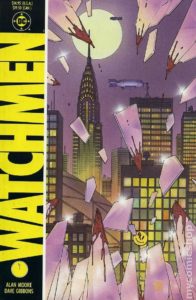 A comic about comics; this meta-comic gives a brief history of superhero comics, then proceeds to deconstruct the genre as it examines the real-world, complex psychology of people who would dress up in tights and fight crime. In the comic, we can read another comic over the shoulder of a character; this is an example of a mise en abyme, a work within a work, and it helps us to understand the complex morality of the larger tale.
A comic about comics; this meta-comic gives a brief history of superhero comics, then proceeds to deconstruct the genre as it examines the real-world, complex psychology of people who would dress up in tights and fight crime. In the comic, we can read another comic over the shoulder of a character; this is an example of a mise en abyme, a work within a work, and it helps us to understand the complex morality of the larger tale.
See my post: Watchmen: A Comic.
Link to Amazon
Moore, Alan and Kevin O’Neill. The League of Extraordinary Gentlemen. 1999.
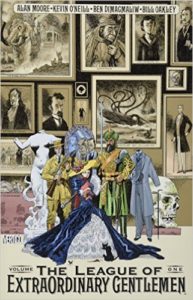 This comic is metafictional because it merges “characters or elements from diverse works of fiction into a new fictional scenario” (Webster Online Dictionary).
This comic is metafictional because it merges “characters or elements from diverse works of fiction into a new fictional scenario” (Webster Online Dictionary).
Link to Amazon
Mulligan, Spike. Puckoon. 1963.
 Characters realize they are in a work of fiction. “The protagonist of the novel is the feckless Dan Milligan, a man so lazy that the author is obliged to take direct action to prevent him spending the entire novel lounging about at home; thus alerted to his status as a fictional character, Dan frequently breaks the fourth wall, speaking directly to the writer about the trouble he has been made to endure,” says Wikipedia.
Characters realize they are in a work of fiction. “The protagonist of the novel is the feckless Dan Milligan, a man so lazy that the author is obliged to take direct action to prevent him spending the entire novel lounging about at home; thus alerted to his status as a fictional character, Dan frequently breaks the fourth wall, speaking directly to the writer about the trouble he has been made to endure,” says Wikipedia.
Link to Amazon
Nabokov, Vladimir. Pale Fire. 1962.
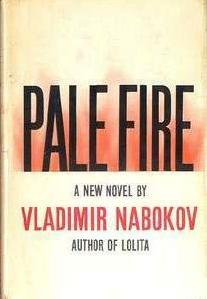 Includes the typical metafictional (and postmodern) convention of “Narrative footnotes, which continue the story while commenting on it” (Webster Online Dictionary). (Read my post: “Zemblan Pizza Resembles Nabokov.”)
Includes the typical metafictional (and postmodern) convention of “Narrative footnotes, which continue the story while commenting on it” (Webster Online Dictionary). (Read my post: “Zemblan Pizza Resembles Nabokov.”)
Link to Amazon
O’Brien, Tim. “The Things They Carried.” The Things They Carried. 1990.
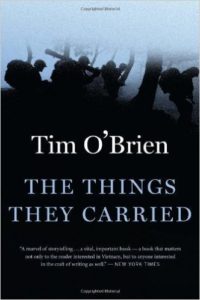 “The Things They Carried” is a short work of fiction. The Things They Carried is also the name of what could be called a short-story collection or perhaps a meta-fictional novel, a pastiche of fiction, nonfiction, fantasy, memoir, author’s notations, and literary commentary. Although the opening story stands alone as a work of fiction, it also functions as an introduction to the larger book. It establishes the major characters that recur throughout the “novel” and introduces many of the topics the book explores, themes as concrete as the Vietnam War and as abstract as how someone tells the truth about a historical event. O’Brien felt that straight facts could not convey an experience as ambiguous and disturbing as the Vietnam war. Yet O’Brien does not wholly rely on fiction either. He interweaves fact and fiction in the story (and throughout the book) to give the reader a more comprehensive sense of what it was really like to fight in Vietnam, to live in the face of death, and to carry on a purposeless existence. (I invite you to read my popular essay: The Burden of Life: Tim O’Brien’s “The Things They Carried.“)
“The Things They Carried” is a short work of fiction. The Things They Carried is also the name of what could be called a short-story collection or perhaps a meta-fictional novel, a pastiche of fiction, nonfiction, fantasy, memoir, author’s notations, and literary commentary. Although the opening story stands alone as a work of fiction, it also functions as an introduction to the larger book. It establishes the major characters that recur throughout the “novel” and introduces many of the topics the book explores, themes as concrete as the Vietnam War and as abstract as how someone tells the truth about a historical event. O’Brien felt that straight facts could not convey an experience as ambiguous and disturbing as the Vietnam war. Yet O’Brien does not wholly rely on fiction either. He interweaves fact and fiction in the story (and throughout the book) to give the reader a more comprehensive sense of what it was really like to fight in Vietnam, to live in the face of death, and to carry on a purposeless existence. (I invite you to read my popular essay: The Burden of Life: Tim O’Brien’s “The Things They Carried.“)
Link to Amazon
O’Nolan, Brian. At Swim-Two-Birds. 1939.
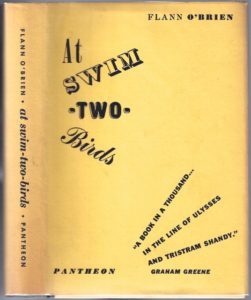 “The story is about an author that writes a story about an author whose characters rise up out of the fictional novelist’s story to rebel against the plot,” according to “Metafiction” at literaturejunction.com.
“The story is about an author that writes a story about an author whose characters rise up out of the fictional novelist’s story to rebel against the plot,” according to “Metafiction” at literaturejunction.com.
Link to Amazon
Ovid. Metamorphoses. 8.
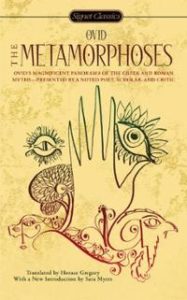 This collection of tales of various types of mythological metamorphoses spends a great deal of time on the transformative power of myth and story-telling.
This collection of tales of various types of mythological metamorphoses spends a great deal of time on the transformative power of myth and story-telling.
Link to Amazon
Palahniuk, Chuck. Fight Club.
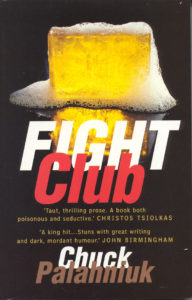 The novel plays with levels of reality. The narrator creates a tougher, more confident version of himself to live out his fantasies in ways that he would be unable to do. He fights himself for fun and creates a fight club in which everyone needs to dress the same way, blurring the lines between characters. Similarly, writers often create main characters that contain traits that the writer lacks, either idealized traits or suppressed elements of their psyche. When asked which character best represents them in a novel, writers sometimes say “All of them.” The 1999 film is even more metafictional as the characters often address viewers directly and seem to know that they are in a film.
The novel plays with levels of reality. The narrator creates a tougher, more confident version of himself to live out his fantasies in ways that he would be unable to do. He fights himself for fun and creates a fight club in which everyone needs to dress the same way, blurring the lines between characters. Similarly, writers often create main characters that contain traits that the writer lacks, either idealized traits or suppressed elements of their psyche. When asked which character best represents them in a novel, writers sometimes say “All of them.” The 1999 film is even more metafictional as the characters often address viewers directly and seem to know that they are in a film.
Link to Amazon
–. Haunted. 2005.
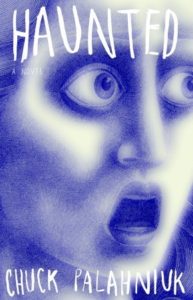 This book blurs genre and plays with narrative forms: “The plot is a frame story for a series of 23 short stories, most preceded by a free verse poem. Each story is followed by a chapter of the main narrative, is told by a character in main narrative, and ties back into the main story in some way,” according to Wikipedia.
This book blurs genre and plays with narrative forms: “The plot is a frame story for a series of 23 short stories, most preceded by a free verse poem. Each story is followed by a chapter of the main narrative, is told by a character in main narrative, and ties back into the main story in some way,” according to Wikipedia.
Link to Amazon
Phillips, Arthur. The Tragedy of Arthur. 2011.
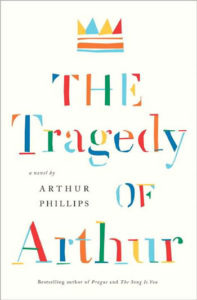 “In true Pale Fire form, this book is a play, with commentary on the play. And not just any play — we’re talking a previously undiscovered work by Shakespeare, which Arthur inherits from his con artist father. Is it real? Is it a work of genius? Does it matter? You’ll have more fun than the novel’s protagonist parsing it all out, that’s for sure,” writes Emily Temple in “10 Phenomenally Tricky Books Everyone Should Read.”
“In true Pale Fire form, this book is a play, with commentary on the play. And not just any play — we’re talking a previously undiscovered work by Shakespeare, which Arthur inherits from his con artist father. Is it real? Is it a work of genius? Does it matter? You’ll have more fun than the novel’s protagonist parsing it all out, that’s for sure,” writes Emily Temple in “10 Phenomenally Tricky Books Everyone Should Read.”
Link to Amazon
Pirandello, Luigi. Six Characters in Search of an Author: A Comedy in the Making. 1921.
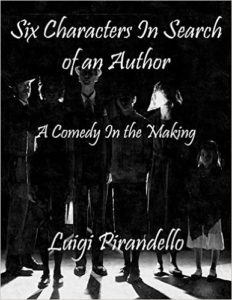 A puzzling and entertaining classic of metatheater: “An acting company prepares to rehearse a play, The Rules of the Game by Luigi Pirandello. As the rehearsal is about to begin the play is unexpectedly interrupted by the arrival of six strange people. The Director of the play, furious at the interruption, demands an explanation. The Father explains that they are unfinished characters in search of an author to finish their story. The Director initially believes them to be mad, but as they begin to argue amongst themselves and reveal details of their story he begins to listen. While he isn’t an author, the Director agrees to stage their story despite the disbelief amongst the jeering actors,” according to Wikipedia.
A puzzling and entertaining classic of metatheater: “An acting company prepares to rehearse a play, The Rules of the Game by Luigi Pirandello. As the rehearsal is about to begin the play is unexpectedly interrupted by the arrival of six strange people. The Director of the play, furious at the interruption, demands an explanation. The Father explains that they are unfinished characters in search of an author to finish their story. The Director initially believes them to be mad, but as they begin to argue amongst themselves and reveal details of their story he begins to listen. While he isn’t an author, the Director agrees to stage their story despite the disbelief amongst the jeering actors,” according to Wikipedia.
Online version / Link to Amazon
Plascencia, Salvador. The People of Paper. 2006.
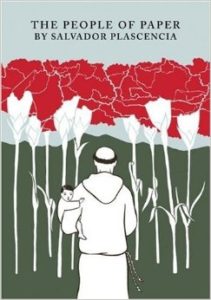 The title itself is metafictional, reminding the reader that characters are people of paper, although we are easily fooled. The author himself appears as a character, but this fictional presentation of self is still a paper person. “The book is notable for its unique layout, featuring columns of text running in different directions across the page, blacked out sections, and a name that has literally been cut out of the novel. The central events depicted in the novel are variously described as a war against Saturn (representing the author), against sadness, and against omniscient narration,” writes Wikipedia.
The title itself is metafictional, reminding the reader that characters are people of paper, although we are easily fooled. The author himself appears as a character, but this fictional presentation of self is still a paper person. “The book is notable for its unique layout, featuring columns of text running in different directions across the page, blacked out sections, and a name that has literally been cut out of the novel. The central events depicted in the novel are variously described as a war against Saturn (representing the author), against sadness, and against omniscient narration,” writes Wikipedia.
Link to Amazon
Plato. Phaedrus. circa 370 B.C.E.
Plato criticizes writing, but he does it through writing. He also bans poets from his utopian Republic although his own writing is quite poetic. We cannot simply say that Plato dismisses writing altogether when he spends so much effort producing some of the most beautiful philosophical prose in world history. We have to take this self-reflexivity as paradoxical and ironic.
Link to Amazon
Pynchon, Thomas. The Crying of Lot 49. 1966.
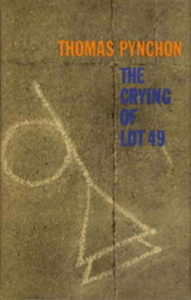 Does the world make sense or are we crazy to think so? Is there a message in the noise and confusion of life, or are we just paranoid to think so? Does this novel mean anything or am I just as insane as the main character Oedipa Mas? (Read my post Message or Madness?: Thomas Pynchon’s Crying of Lot 49. Nobody speaks in their own voice. When we open our mouths choruses of voices echo through our own voice. Explore the heteroglossia of the novel in my post A Walking Assembly of Man: Many Voices Crying Lot 49.)
Does the world make sense or are we crazy to think so? Is there a message in the noise and confusion of life, or are we just paranoid to think so? Does this novel mean anything or am I just as insane as the main character Oedipa Mas? (Read my post Message or Madness?: Thomas Pynchon’s Crying of Lot 49. Nobody speaks in their own voice. When we open our mouths choruses of voices echo through our own voice. Explore the heteroglossia of the novel in my post A Walking Assembly of Man: Many Voices Crying Lot 49.)
Link to Amazon
–-. Gravity’s Rainbow. 1973.
 “Throughout Gravity’s Rainbow, Pynchon questions how history gets created, why it is created, who creates it, and its role in constructing both individual and communal identities. Many of the characters express views about history, and almost all of the characters speculate fearfully about a loss of the past, or the end of history,” according to “Gravity’s Rainbow as Historiographic Metafiction” on the blog Engl 693.
“Throughout Gravity’s Rainbow, Pynchon questions how history gets created, why it is created, who creates it, and its role in constructing both individual and communal identities. Many of the characters express views about history, and almost all of the characters speculate fearfully about a loss of the past, or the end of history,” according to “Gravity’s Rainbow as Historiographic Metafiction” on the blog Engl 693.
Link to Amazon
–. Mason & Dixon. 1997.
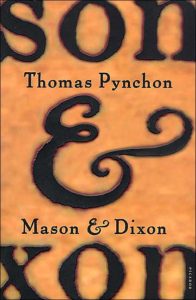 Mason & Dixon “centers on the collaboration of the historical Charles Mason and Jeremiah Dixon.” The novel intermingles “Mason and Dixon’s biographies, history, fantasy, legend, speculation, and outright fabrication,” writes Wikipedia.
Mason & Dixon “centers on the collaboration of the historical Charles Mason and Jeremiah Dixon.” The novel intermingles “Mason and Dixon’s biographies, history, fantasy, legend, speculation, and outright fabrication,” writes Wikipedia.
Link to Amazon
–. V. 1963.
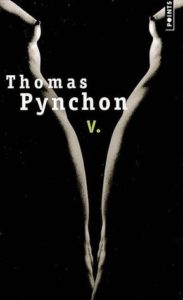 The novel explores “the processes of the human mind and of literature as effective interpretive methods. It assumes that both can establish valid links between life and the subject and, what is relevant here, that literature is a reliable tool for the analysis of reality. . . . V. provides an original view of social commitment in literature, and how this view is based on a different notion of literature as method of analysis which the novel introduces. In order to do this, I will study V. as a parody of reflexive literature and its mechanisms. V. therefore transcends reflexivity, proposing a return to social commitment and a rejection of reflexivity’s self-indulgence,” argues Luis Miguel Garci Mainar in Metafiction and Social Commitment in Pynchon’s V.
The novel explores “the processes of the human mind and of literature as effective interpretive methods. It assumes that both can establish valid links between life and the subject and, what is relevant here, that literature is a reliable tool for the analysis of reality. . . . V. provides an original view of social commitment in literature, and how this view is based on a different notion of literature as method of analysis which the novel introduces. In order to do this, I will study V. as a parody of reflexive literature and its mechanisms. V. therefore transcends reflexivity, proposing a return to social commitment and a rejection of reflexivity’s self-indulgence,” argues Luis Miguel Garci Mainar in Metafiction and Social Commitment in Pynchon’s V.
Link to Amazon
Randall, Alice. The Wind Done Gone. 2001.
 Gone with the Wind is turned upside down as it is told from the perspective of Cynara, a mulatt0 slave who is the daughter of Mammy and Scarlet O’Hara’s father.
Gone with the Wind is turned upside down as it is told from the perspective of Cynara, a mulatt0 slave who is the daughter of Mammy and Scarlet O’Hara’s father.
Link to Amazon
Reed, Ismael. Mumbo Jumbo. 1972. 218 pgs.
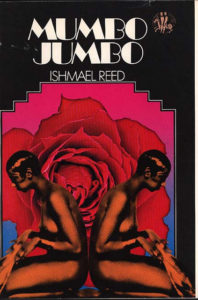 Reed’s novel blurs lines between history and fiction. “Mumbo Jumbo is Ishmael Reed’s brilliantly satiric deconstruction of Western civilization . . . In it, Reed . . . mixes portraits of historical figures and fictional characters” (from the back of the book). (Read about the problematic distinction between history and fiction in in my book Narrative Madness and the following posts on my blog: The Conventions of Metafiction, Relevance of Metafiction in the Age of Information, History is an Angel Blown Backward through Time, La Mancha: The Stain of Truth, It’s All Fiction: Another Attempt to Tell the Story, and A Not-Not True Tale about a Very Short, Simple Morning.)
Reed’s novel blurs lines between history and fiction. “Mumbo Jumbo is Ishmael Reed’s brilliantly satiric deconstruction of Western civilization . . . In it, Reed . . . mixes portraits of historical figures and fictional characters” (from the back of the book). (Read about the problematic distinction between history and fiction in in my book Narrative Madness and the following posts on my blog: The Conventions of Metafiction, Relevance of Metafiction in the Age of Information, History is an Angel Blown Backward through Time, La Mancha: The Stain of Truth, It’s All Fiction: Another Attempt to Tell the Story, and A Not-Not True Tale about a Very Short, Simple Morning.)
Link to Amazon
Rhys, Jean. The Wide Sargasso Sea: A Novel. 1966.
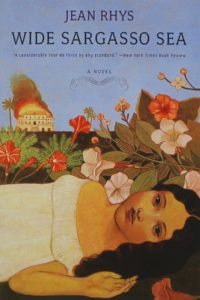 This prequel to Charlotte Bronte’s Jane Eyre reinvents the story.
This prequel to Charlotte Bronte’s Jane Eyre reinvents the story.
Link to Amazon
Robbins, Tom. Even Cowgirls Get the Blues. 1976.
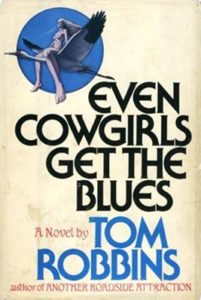 The author appears as a character in his own book.
The author appears as a character in his own book.
Link to Amazon
Salinger, J. D. “The Laughing Man.” Nine Stories. 1953.
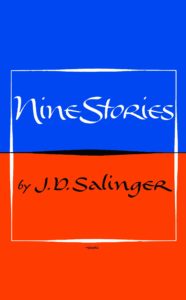 A story about story-telling. “The Chief,” the leader of a group of boys, called the Comanche Club, tells ongoing serial adventure stories about the laughing man. The story affects the real lives of the boys, inspiring them to be bold and adventurous; however, real life also affects the story and when the Chief has troubles with his girlfriend (maybe he gets her pregnant?), he kills off the hero, to the dismay and disappointment of the boys. The story troubles our artificial separation of fiction from real life.
A story about story-telling. “The Chief,” the leader of a group of boys, called the Comanche Club, tells ongoing serial adventure stories about the laughing man. The story affects the real lives of the boys, inspiring them to be bold and adventurous; however, real life also affects the story and when the Chief has troubles with his girlfriend (maybe he gets her pregnant?), he kills off the hero, to the dismay and disappointment of the boys. The story troubles our artificial separation of fiction from real life.
(Read more about the interconnectedness of fiction and reality in my book Narrative Madness and my blog posts Purpose: To Rehabilitate Reality through Metafiction and Understanding is Making Up Stories about Chaos.)
Link to Amazon
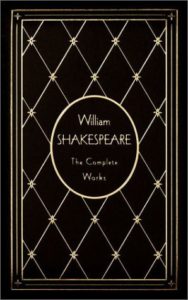 Shakespeare, William. Plays in Shakespeare that present a play within a play: Hamlet (Mousetrap), Midsummer Night’s Dream (Pyramus and Thisbe), Love’s Labour’s Lost (Nine Worthies), The Tempest (“Pageant” and perhaps the whole play is a play within a play, a theatrical representation of theater), The Taming of the Shrew (The Taming of the Shrew–the entire play is a play within a play set up in the Induction), The Merry Wives of Windsor (“Fairy Pageant”), Troilus & Cressida (Ulysses describes others doing impersonations of generals), Henry IV, Pt. 1 (in the Boar’s Head Tavern scene, Falstaff and Henry role play Henry’s coming meeting with his father), Henry VIII (Katherine’s mask vision), King Lear (mock trial), Macbeth (“Show of 8 Kings”), Cymbeline (Posthumus’s dream of Jupiter & ghosts), Pericles (the dumb show or mime show). (Read about The Tempest in The Stuff That Dreams are Made of: The Real, the Unreal, and the Maltese Falcon and Midsummer Night’s Dream in Merrily, Merrily, Not So Merrily, Love is But a Dream (Says Shakespeare in His Metaplay A Midsummer Night’s Dream). Read about the play within a play in my post: The Mirror in the Text, Part III: The Mirror in the Text.)
Shakespeare, William. Plays in Shakespeare that present a play within a play: Hamlet (Mousetrap), Midsummer Night’s Dream (Pyramus and Thisbe), Love’s Labour’s Lost (Nine Worthies), The Tempest (“Pageant” and perhaps the whole play is a play within a play, a theatrical representation of theater), The Taming of the Shrew (The Taming of the Shrew–the entire play is a play within a play set up in the Induction), The Merry Wives of Windsor (“Fairy Pageant”), Troilus & Cressida (Ulysses describes others doing impersonations of generals), Henry IV, Pt. 1 (in the Boar’s Head Tavern scene, Falstaff and Henry role play Henry’s coming meeting with his father), Henry VIII (Katherine’s mask vision), King Lear (mock trial), Macbeth (“Show of 8 Kings”), Cymbeline (Posthumus’s dream of Jupiter & ghosts), Pericles (the dumb show or mime show). (Read about The Tempest in The Stuff That Dreams are Made of: The Real, the Unreal, and the Maltese Falcon and Midsummer Night’s Dream in Merrily, Merrily, Not So Merrily, Love is But a Dream (Says Shakespeare in His Metaplay A Midsummer Night’s Dream). Read about the play within a play in my post: The Mirror in the Text, Part III: The Mirror in the Text.)
Online edition / Link to Amazon
Shea, Robert and Robert Anton Wilson. Illuminatus Trilogy. 1975.
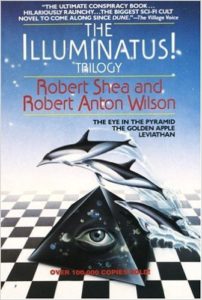 “The major protagonists, now gathered together onboard the submarine, are menaced by the Leviathan, a giant, pyramid-shaped single-cell sea monster that has been growing in size for hundreds of millions of years. The over-the-top nature of this encounter leads some of the characters to question whether they are merely characters in a book. This metafictional note is swiftly rejected (or ignored) as they turn their attention to the monster again,” says Wikipedia.
“The major protagonists, now gathered together onboard the submarine, are menaced by the Leviathan, a giant, pyramid-shaped single-cell sea monster that has been growing in size for hundreds of millions of years. The over-the-top nature of this encounter leads some of the characters to question whether they are merely characters in a book. This metafictional note is swiftly rejected (or ignored) as they turn their attention to the monster again,” says Wikipedia.
Link to Amazon
Snickett, Lemony. A Series of Unfortunate Events. 1999-2006.
 “The entire series is actively narrated by Snicket, who makes numerous references to his mysterious, deceased love interest, Beatrice. Both Snicket and Beatrice play roles in the story along with Snicket’s family members, all of whom are part of an overarching conspiracy known to the children only as ‘V.F.D.,'” says Wikipedia.
“The entire series is actively narrated by Snicket, who makes numerous references to his mysterious, deceased love interest, Beatrice. Both Snicket and Beatrice play roles in the story along with Snicket’s family members, all of whom are part of an overarching conspiracy known to the children only as ‘V.F.D.,'” says Wikipedia.
Link to Amazon
Sorrentino, Gilberto. –. Mulligan Stew. 1978.
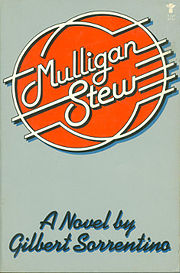 “Perhaps the most provocative example of the uninhibited comedy of metafiction is to be found in the fiction of Gilbert Sorrentino . . . Sorrentino is probably the most programmatically selfreflexive of contemporary American writers, as each of his novels . . . from Imaginative Qualities of Actual Things (1971) to Mulligan Stew (1978) and beyond manifests an insistent, clearly intentional effort to ‘bare the device.’ Although Imaginative Qualities, a novel in which the ‘author’ lets his readers in on the creation of his characters and their stories, remains a prototypical metafiction of the same period as Barth’s ‘Lost in the Funhouse’ and Coover’s ‘Universal Baseball Association,” Mulligan Stew takes the self-reflexive technique to its most outrageous extreme,” argues Daniel Green in “‘Terribly Bookish’: Mulligan Stew and the Comedy of Self-Reflexivity” by Daniel Green.
“Perhaps the most provocative example of the uninhibited comedy of metafiction is to be found in the fiction of Gilbert Sorrentino . . . Sorrentino is probably the most programmatically selfreflexive of contemporary American writers, as each of his novels . . . from Imaginative Qualities of Actual Things (1971) to Mulligan Stew (1978) and beyond manifests an insistent, clearly intentional effort to ‘bare the device.’ Although Imaginative Qualities, a novel in which the ‘author’ lets his readers in on the creation of his characters and their stories, remains a prototypical metafiction of the same period as Barth’s ‘Lost in the Funhouse’ and Coover’s ‘Universal Baseball Association,” Mulligan Stew takes the self-reflexive technique to its most outrageous extreme,” argues Daniel Green in “‘Terribly Bookish’: Mulligan Stew and the Comedy of Self-Reflexivity” by Daniel Green.
Link to Amazon
Spenser, Edmund. The Faerie Queene. 1590, 1596.
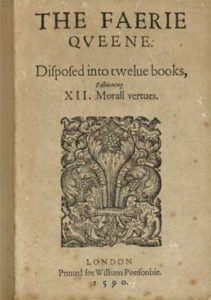 Full of references to writing, ink, poetry, and “glass,” meaning mostly the mirror that art holds up to nature. Very much a poem about poetry. (Read my meta-allegory about the allegorical work: Why Read Spenser When Allegory Invites Despayr?)
Full of references to writing, ink, poetry, and “glass,” meaning mostly the mirror that art holds up to nature. Very much a poem about poetry. (Read my meta-allegory about the allegorical work: Why Read Spenser When Allegory Invites Despayr?)
Link to Amazon
Sterne, Laurence. The Life and Opinions of Tristram Shandy, Gentleman. 1759-1767.
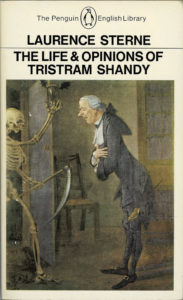 Description: A postmodern book long before postmodernism. Tristram Shandy begins to tell the story of his life, but needs to digress to set up the scene of his conception, but needs another digression to set that scene up and so on. The story is told backwards and yet still manages to move forward, makes us aware of the conventions of storytelling. Very inventive typography draws our attention to the materiality of the book: end pages, binding, ink and paper. (Check out my posts: Tristram Shandy ****s Up the Page, Progressive Digressions in Tristram Shandy, The Stuff That Dreams are Made of: Paper, Ink, Letter and Word, This is not the name of another post about Tristram Shandy, History is an Angel Blown Backward Through Time.)
Description: A postmodern book long before postmodernism. Tristram Shandy begins to tell the story of his life, but needs to digress to set up the scene of his conception, but needs another digression to set that scene up and so on. The story is told backwards and yet still manages to move forward, makes us aware of the conventions of storytelling. Very inventive typography draws our attention to the materiality of the book: end pages, binding, ink and paper. (Check out my posts: Tristram Shandy ****s Up the Page, Progressive Digressions in Tristram Shandy, The Stuff That Dreams are Made of: Paper, Ink, Letter and Word, This is not the name of another post about Tristram Shandy, History is an Angel Blown Backward Through Time.)
Link to Amazon
Stone, John. The Monster at the End of This Book Starring Lovable, Furry Old Grover. Illus. Mike Smollin. 1971.
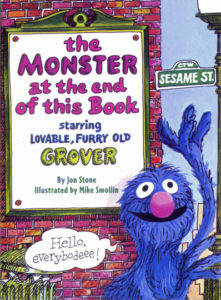 This is a book about reading, in which the main character (Grover) asks you, the reader, to stop reading, because each page you turn brings him closer to the monster at the end of the book. He tries to tie the pages shut and builds a brick wall, but you, a powerful reader, can easily turn past these paper images. (Read my post that takes a surprising twist: Grover and the Monster at the End of the Book (with a Surprise Ending).
This is a book about reading, in which the main character (Grover) asks you, the reader, to stop reading, because each page you turn brings him closer to the monster at the end of the book. He tries to tie the pages shut and builds a brick wall, but you, a powerful reader, can easily turn past these paper images. (Read my post that takes a surprising twist: Grover and the Monster at the End of the Book (with a Surprise Ending).
Link to Amazon
Stoppard, Tom. Rosencrantz and Guilderstern are Dead. 1966.
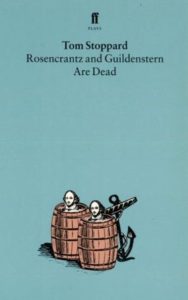 This postmodern play retells the story of Hamlet from the point of view of two very minor, inconsequential characters. “The action of Stoppard’s play takes place mainly “in the wings” of Shakespeare’s, with brief appearances of major characters from Hamlet who enact fragments of the original’s scenes. Between these episodes the two protagonists voice their confusion at the progress of events of which—occurring onstage without them in Hamlet—they have no direct knowledge,” according to Wikipedia.
This postmodern play retells the story of Hamlet from the point of view of two very minor, inconsequential characters. “The action of Stoppard’s play takes place mainly “in the wings” of Shakespeare’s, with brief appearances of major characters from Hamlet who enact fragments of the original’s scenes. Between these episodes the two protagonists voice their confusion at the progress of events of which—occurring onstage without them in Hamlet—they have no direct knowledge,” according to Wikipedia.
Link to Amazon
Suess, Dr. And to Think That I Saw It on Mulberry Street. 1937.
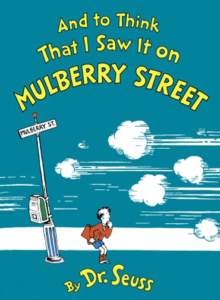 The book is about a story-teller who elaborates on ordinary events to come up with incredible stories about his walk to and from school. In the morning, his father always instructs him to “Stop telling such outlandish tales. Stop turning minnows into whales.” On his walk home, Marco sees nothing more interesting than a horse and wagon, but imagines it as a horse and zebra, then keeps elaborating on his story until it becomes a massive, absurd, and impossible parade. When he gets home, however, he tells his prosaic father, who has warned him not to tell fanciful stories, only about the horse and wagon. The book then becomes a comment on parents who try to rein in children’s imaginations, and an encouragement for children (and other readers) to let their imaginations roam.
The book is about a story-teller who elaborates on ordinary events to come up with incredible stories about his walk to and from school. In the morning, his father always instructs him to “Stop telling such outlandish tales. Stop turning minnows into whales.” On his walk home, Marco sees nothing more interesting than a horse and wagon, but imagines it as a horse and zebra, then keeps elaborating on his story until it becomes a massive, absurd, and impossible parade. When he gets home, however, he tells his prosaic father, who has warned him not to tell fanciful stories, only about the horse and wagon. The book then becomes a comment on parents who try to rein in children’s imaginations, and an encouragement for children (and other readers) to let their imaginations roam.
Link to Amazon.
–. On Beyond Zebra. 1955.
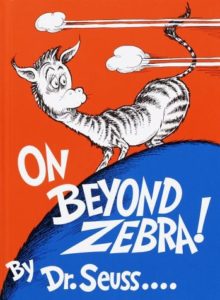 The letters we use limit the things we can talk about, so Dr. Seuss gleefully continues the alphabet, introducing many wonderful Seussian creatures. (Read my post: The Limits of Language: Seuss Beyond Zebra.)
The letters we use limit the things we can talk about, so Dr. Seuss gleefully continues the alphabet, introducing many wonderful Seussian creatures. (Read my post: The Limits of Language: Seuss Beyond Zebra.)
Link to Amazon
Vonnegut, Kurt. Breakfast of Champions, or Goodbye Blue Monday. 1973.
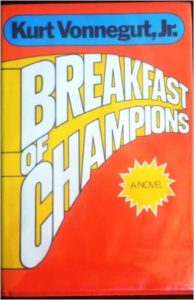 “Kilgore Trout is a widely published, but otherwise unsung and virtually invisible writer who, by a fluke, is invited to deliver a keynote address at a local arts festival in distant Midland City. Dwayne Hoover is a wealthy businessman who owns much of Midland City, but is mentally unstable and is undergoing a gradual mental collapse. Kilgore arrives in Midland City and, by happenstance, piques the interest of Dwayne. A confused Dwayne demands a message from Kilgore, who hands over a copy of his novel. Dwayne reads the novel, which purports to be a message from the Creator of the Universe explaining that the reader – in this case Dwayne – is the only individual in the universe with free will. Everyone else is a robot. Dwayne believes the novel to be factual and immediately goes on a violent rampage, severely beating his son, his lover, and nine other people before being taken into custody. While Kilgore is walking the streets of Midland after Dwayne’s rampage the narrator of the book approaches Kilgore. The narrator tells Kilgore of his existence, the narrator lets Kilgore be free and to be under his own will,” writes Wikipedia.
“Kilgore Trout is a widely published, but otherwise unsung and virtually invisible writer who, by a fluke, is invited to deliver a keynote address at a local arts festival in distant Midland City. Dwayne Hoover is a wealthy businessman who owns much of Midland City, but is mentally unstable and is undergoing a gradual mental collapse. Kilgore arrives in Midland City and, by happenstance, piques the interest of Dwayne. A confused Dwayne demands a message from Kilgore, who hands over a copy of his novel. Dwayne reads the novel, which purports to be a message from the Creator of the Universe explaining that the reader – in this case Dwayne – is the only individual in the universe with free will. Everyone else is a robot. Dwayne believes the novel to be factual and immediately goes on a violent rampage, severely beating his son, his lover, and nine other people before being taken into custody. While Kilgore is walking the streets of Midland after Dwayne’s rampage the narrator of the book approaches Kilgore. The narrator tells Kilgore of his existence, the narrator lets Kilgore be free and to be under his own will,” writes Wikipedia.
Link to Amazon
–. Slaughterhouse-Five, or The Children’s Crusade: A Duty-Dance with Death. 1969.
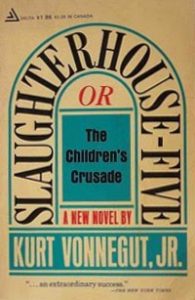 ‘That was I,’ says the narrator of Slaughterhouse-Five. ‘That was me. That was the author of this book’ (Vonnegut 160). Careful and specific, these words leave little doubt that the narrator of Slaughterhouse-Five is indeed its author. Kurt Vonnegut as writer and narrator intrudes on his own work, makes himself a character in his own fictional world,” says Bradley Warshauer in “Metafiction in Slaughterhouse-Five.”
‘That was I,’ says the narrator of Slaughterhouse-Five. ‘That was me. That was the author of this book’ (Vonnegut 160). Careful and specific, these words leave little doubt that the narrator of Slaughterhouse-Five is indeed its author. Kurt Vonnegut as writer and narrator intrudes on his own work, makes himself a character in his own fictional world,” says Bradley Warshauer in “Metafiction in Slaughterhouse-Five.”
Link to Amazon
Wallace, David Foster. Infinite Jest. 1996.
 Includes the typical metafictional (and postmodern) convention of narrative footnotes: “The novel includes 388 numbered endnotes (some of which have footnotes of their own) that explain or expound on points in the story. In an interview with Charlie Rose, Wallace characterized their use as a method of disrupting the linearity of the text while maintaining some sense of narrative cohesion,” says Wikipedia.
Includes the typical metafictional (and postmodern) convention of narrative footnotes: “The novel includes 388 numbered endnotes (some of which have footnotes of their own) that explain or expound on points in the story. In an interview with Charlie Rose, Wallace characterized their use as a method of disrupting the linearity of the text while maintaining some sense of narrative cohesion,” says Wikipedia.
Link to Amazon
–. “Octet.” Brief Interviews with Hideous Men. 1999.
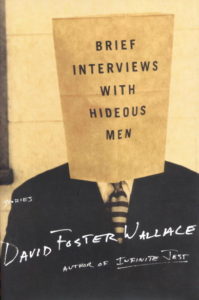 This highly metafictional short work of fiction begins as a pop quiz on question number four, but becomes an obsessively self-referential examination of fiction-writing. (Check out my critique in The Danger of Meta: Pompidou and David Foster Wallace’s ‘Octet.‘”)
This highly metafictional short work of fiction begins as a pop quiz on question number four, but becomes an obsessively self-referential examination of fiction-writing. (Check out my critique in The Danger of Meta: Pompidou and David Foster Wallace’s ‘Octet.‘”)
Link to Amazon
Woolf, Virginia. Mrs. Dalloway. 1925.
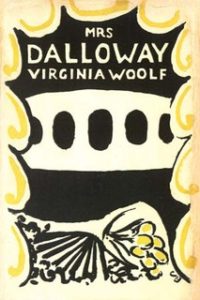 “Literary allusions in Mrs. Dalloway abound in bookish relationships that encompass much more than a reading list for World Lit 101. The significances within this mosaic, moreover, demonstrate a quasi-Darwinian phenomenon, that books descend from books (Woolf, “The Leaning Tower). Obscurities here concern plots, myths, language living and dead to such a large degree that they exert a metaliterary influence,” claims Molly Hoff in Viriginia Woolf’s Mrs. Dalloway: Invisibile Presences.
“Literary allusions in Mrs. Dalloway abound in bookish relationships that encompass much more than a reading list for World Lit 101. The significances within this mosaic, moreover, demonstrate a quasi-Darwinian phenomenon, that books descend from books (Woolf, “The Leaning Tower). Obscurities here concern plots, myths, language living and dead to such a large degree that they exert a metaliterary influence,” claims Molly Hoff in Viriginia Woolf’s Mrs. Dalloway: Invisibile Presences.
Link to Amazon
Thanks for sharing the useful information. Actually, I just love to read metafictional novels. I read many metafictional novels and now I am looking for the more. And now I am thinking that after reading your article my search ends here.
The Cream of the Jest
by James Branch Cabell
No Alice in Wonderland? It is pure Quijote.
Stylish Transient is the most meta-nonfictional book in the last ever!
https://www.amazon.com/Stylish-Transient-Novel-DJ-Rankin-ebook/dp/B0CYCY5CWN